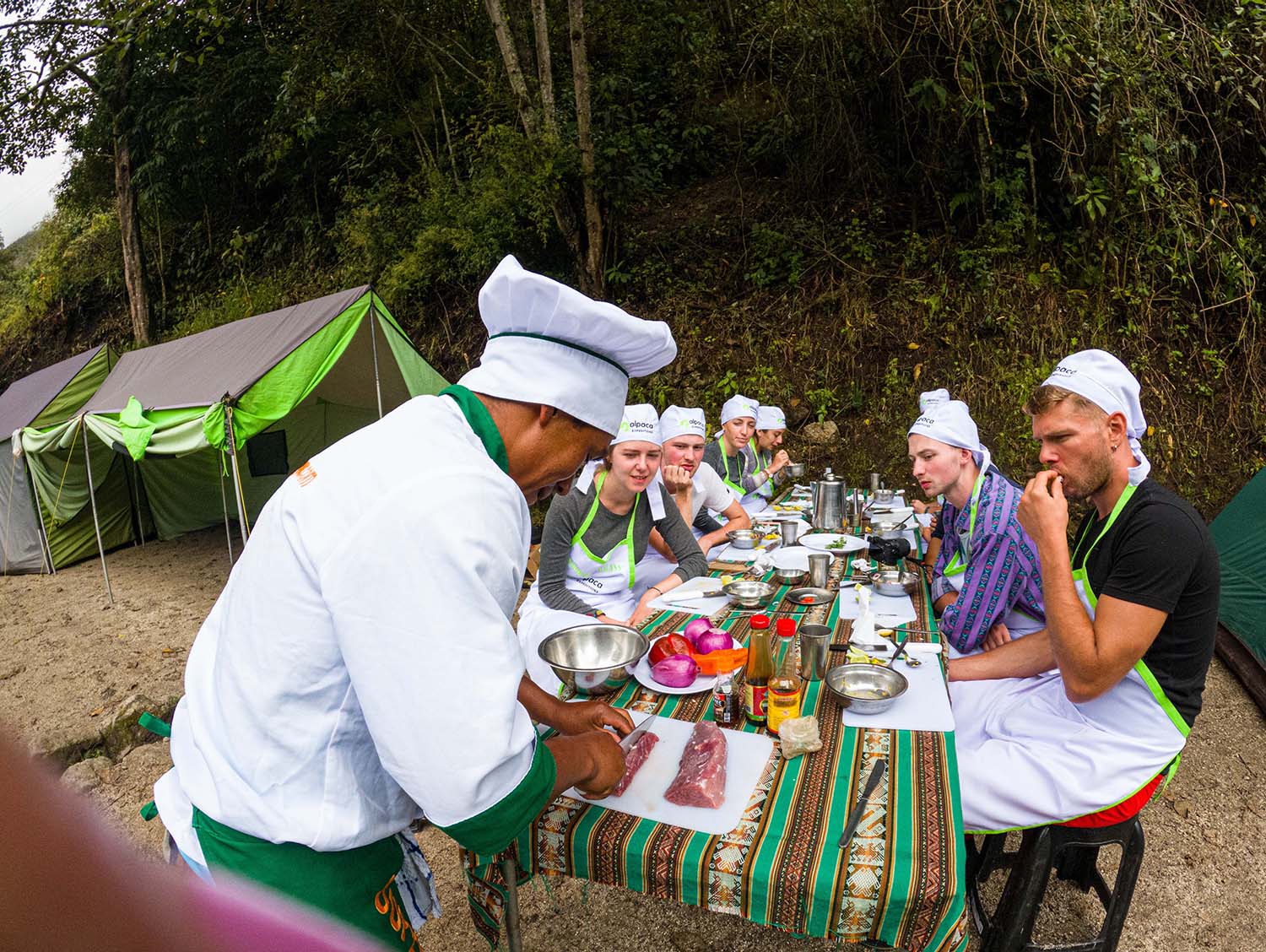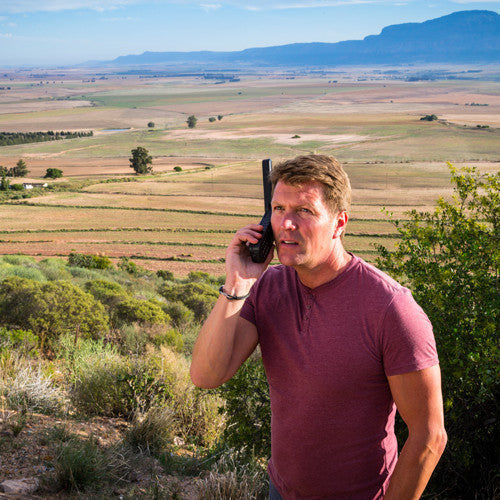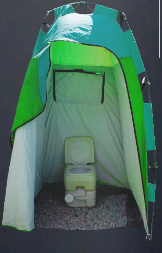Top 50 Questions about the Inca Trail
FAQ
Hiking the Inca Trail to Machu Picchu is an incredible once in a lifetime trip for The Inca Understanding what the Inca Trail is all about and getting all your questions answered about hiking it, is really important. Whether you are hiking the entire Classic Inca Trail in 4 or 5 days, or choosing to do a short Inca Trail hike for 2 days – these FAQs will answer all your questions about the Inca Trail. Let’s dig in!
Table of Contents
General inca trail and Machu Picchu
- 1. What is the Inca trail?
- 2. Does the Inca trail go to Machu Picchu?
- 3. What is Machu Picchu?
- 4. Do horses, mules or llamas travel the Inca trail?
- 5. What is the best peak to hike for the amazing views of Machu Picchu?
- 6. What is the difference between Huayna Picchu and Machu Picchu mountain?
Planning your trip to Peru to hike the Inca trail
- 7. What are all the treks that include hiking on the Inca trail?
- 8. How do i book an Inca trail trek?
- 9. What is the difference between a private and group tour?
- 10. Can we pay the remaining balance for the trip using a credit card when we arrive in cusco? or do we have to pay in cash?
- 11. How do permits work for hiking the Inca trail? do you need a permit?
- 12. Updating passport numbers before your Inca trail trek
- 13. How to get to Cusco, Peru
- 14. How do i get from the airport to my hotel? or, how can i find the person who is picking me up at the airport?
- 15. Where to stay in Cusco, Peru
- 16. Can i stay in the Sacred Valley, Peru instead of in Cusco?
- 17. Can i spend an extra night in Aguas calientes, Peru?
- 18. What is Huayna Picchu mountain and where is it?
- 19. What is the Huayna Picchu hike?
- 20. Do most people do the Huayna Picchu mountain hike at Machu Picchu?
- 21. Do i need a tour operator or a guide for the Inca trail?
Weather, seasons, and rainfall on the inca trail
- 22. What will the weather be like on the Inca trail?
- 23. What are the average monthly temperatures on the Inca trail?
- 24. What is the average monthly rainfall on the Inca trail in inches/mm?
- 25. What is the average number of days of rainfall by month on the Inca trail?
Packing for your trek on the Inca trail
- 26. Where do you store luggage while you’re hiking on the Inca trail?
- 27. What do i need to pack to trek/hike the Inca trail?
- 28. What do i need to carry in my daypack on the Inca trail?
- 29. What should i pack if i am doing a 2 day trek?
- 30. Do i need hiking boots to trek the Inca trail?
- 31. Should i use walking sticks on the Inca trail?
- 32. What is the temperature rating of Alpaca Expeditions sleeping bags, liners, and sleeping pads available for rent?
- 33. Is there any location where we can plug and charge our electronic devices on the Inca trail?
- 34. What type of electrical outlets are used in Peru?
- 35. What size day pack is allowed into Machu Picchu?
Physical preparation for your Inca trail trek
- 36. How challenging or hard is the Inca trail?
- 37. What is the elevation gain on the Inca trail hike?
- 38. Is the inca trail to Machu Picchu 5d/4n the same path as the 4 day Inca trail?
- 39. Is there an age limit for the Inca trail?
Stargazing on the inca trail
Porters and the inca trail
- 41. What are inca trail porters, and why are they needed on the Inca trail?
- 42. Should i pay for the extra porter on the Inca trail
- 43. Do i need to tip the porters, chefs, and guides?
Meals, hygiene and safety on the inca trail
- 44. What if an emergency happens on the Inca trail, or a hiker needs medical help?
- 45. Where do i get clean drinking water on the Inca trail?
- 46. What will meals be like on the Inca trail
- 47. Are there bathrooms on the Inca trail?
Covid related faqs for hiking the inca trail
- 48. What are the current covid restrictions in Peru?
- 49. Can i cancel my hike? what is the cancellation policy for the new variants of Covid?
- 50. What are the current covid restrictions on the Inca trail?
- 51. Is it easy to buy a kn95 mask in Cusco? if i wear a kn95, do i need to double mask?
- 52. Is covid testing available on Sundays in Cusco, Peru?
- 53. Can you help me arrange my Covid test?
1. What is the inca trail?
The Inca Trail, also known as the Inka Trail in the Quechua spelling, and the Camino Inca in Spanish, is an ancient hiking footpath that ends at Machu Picchu. There are three known and overlapping sections to the Inca Trail,The three sections are called: Mollepata, Classic, and One Day. The section that tourists hike over the course of 4 or 5 days is the Classic Inca Trail. The One Day section is the last part of the trail before Machu Picchu, and it’s what tourists hike when doing the Two Day or Short Inca Trail Trek. Of the two days, the first day is the one day of hiking to the Sun Gate of Machu Picchu, and the 2nd day is exploring inside Machu Picchu.
2. Does the inca trail go to Machu Picchu?
Yes, it is the ancient footpath of the Incas that goes from the Sacred Valley directly to Machu Picchu. It was created specifically for the Inca people to travel to Machu Picchu.
3. What is Machu Picchu?
Machu Picchu is a 15th-century ancient Incan society situated almost 2500 m above sea level – roughly 8000 feet, and a UNESCO World Heritage site, spanning 32,592 hectares (80,537 acres) of lush mountains and valleys. Nestled among the Andes mountains in the Cusco region in Peru, Machu Picchu attracts as many as 5,000 people a day during the high season between May and October, with about 1 million people visiting the site yearly. (pre-covid). Machu Picchu, the “Lost City of the Incas”, contains approximately 200 ancient Incan stone structures and terraces that have religious, ceremonial, astronomical and agricultural meaning. Read this Guide to Hiking to Machu Picchu for more information.
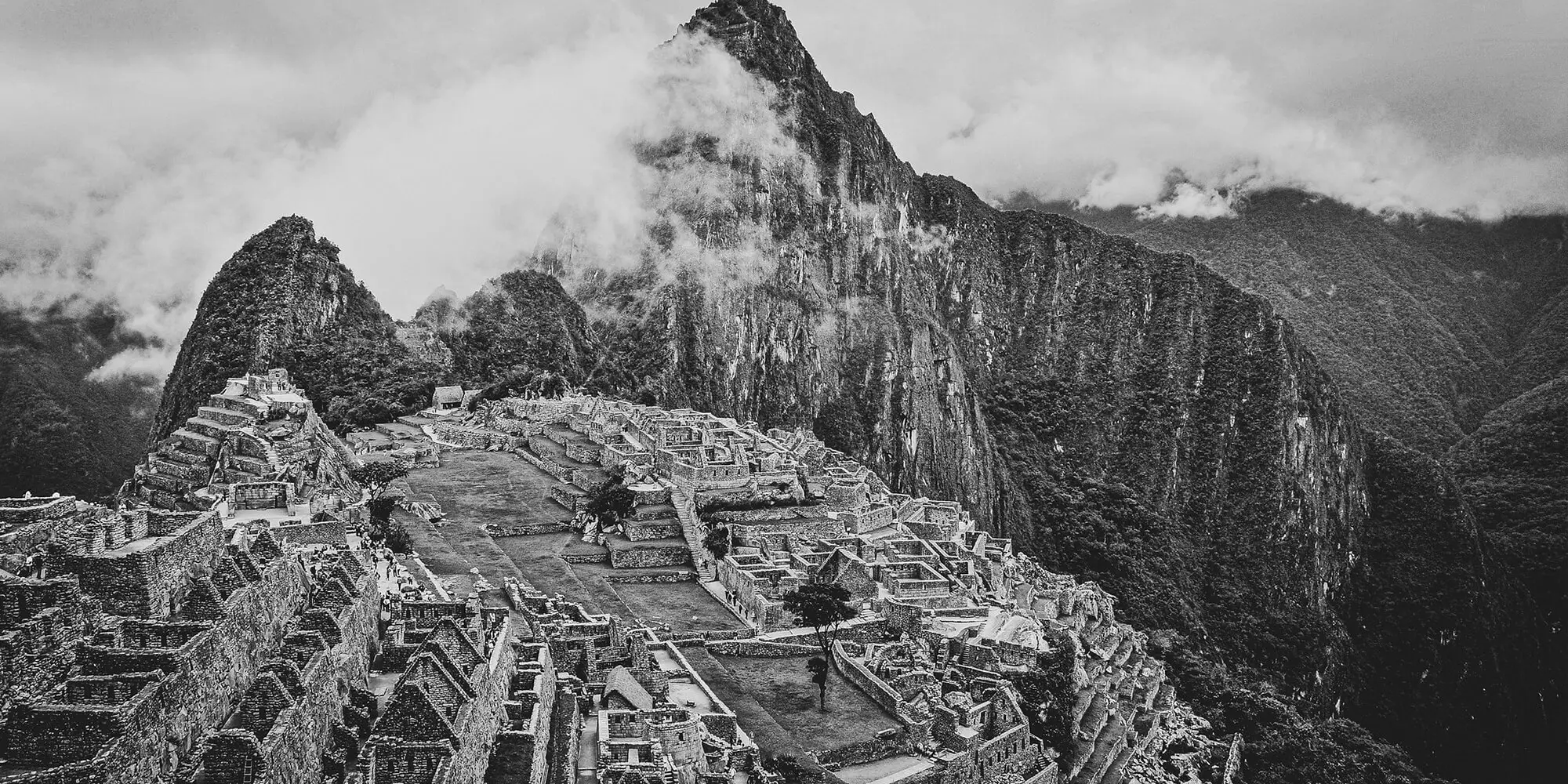
5. What is the best peak to hike for the amazing views of Machu Picchu?
There are three ways to get above Machu Picchu for those amazing pictures you see in books: the Sun Gate, Huaynapicchu and Machu Picchu Mountain (montaña). The Sun Gate is free for everyone to visit and takes about an hour from the bottom of the ruins to the lookout point. This is also where all Inca Trail trekkers enter to see Machu Picchu for the first time. The views are lovely from the gate, but not as high and a bit further than the other two options.
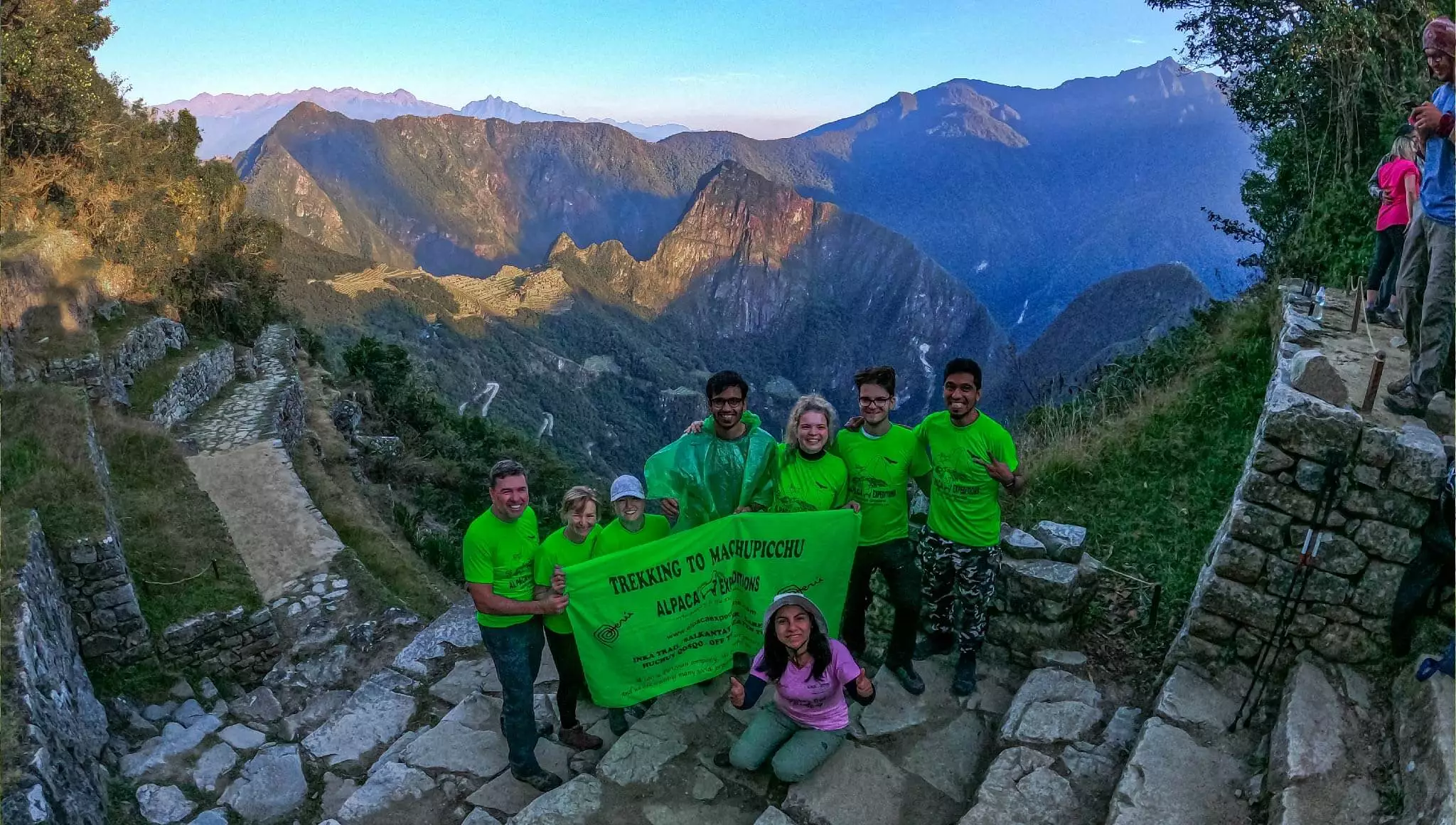
6. What is the difference between Huayna picchu and Machu Picchu mountain?
Both Huaynapicchu and Machu Picchu Mountain are permit restricted hikes that must be done within a certain time. These permits/tickets will be secured by Alpaca Expeditions, but do need to be arranged a few months in advance of your trip. Both offer amazing views of Machu Picchu from viewpoints directly above. Machu Picchu takes about 3 hours to the top and is spectacular on a lovely day, but views are often restricted by clouds. Huaynapicchu takes 45 minutes to the top and is definitely the most popular of the three options. All views are amazing. Click here to watch a short video showing the difference between Machu Picchu mountain and Huaynapicchu.
PLANNING YOUR TRIP TO PERU TO HIKE THE INCA TRAIL
7. What are all the treks that include hiking on the Inca trail?
- Inca Trail Hike 4D/3N & Rainbow Mountain + Red Valley 1 Day
- Inca Trail Hike 2D/1N & Rainbow Mountain + Red Valley 1 Day
- Sacred Valley Tour 1 Day & Inca Trail 2D/1N & Rainbow Mountain + Red Valley 1 Day
- Sacred Valley Tour 1 Day & Inca Trail Hike 2D/1N
- Inca Trail (Classic) 4D/3N Group Tour
- Inca Trail 4D/3N Private Tour
- Short Inca Trail trek with Camping 2D/1N
- Short Inca Trail trek with Hotel 2D/1N
- Machu Picchu Inca Trail 5D/4N
- Salkantay Tour & Inca Trail 7D/6N
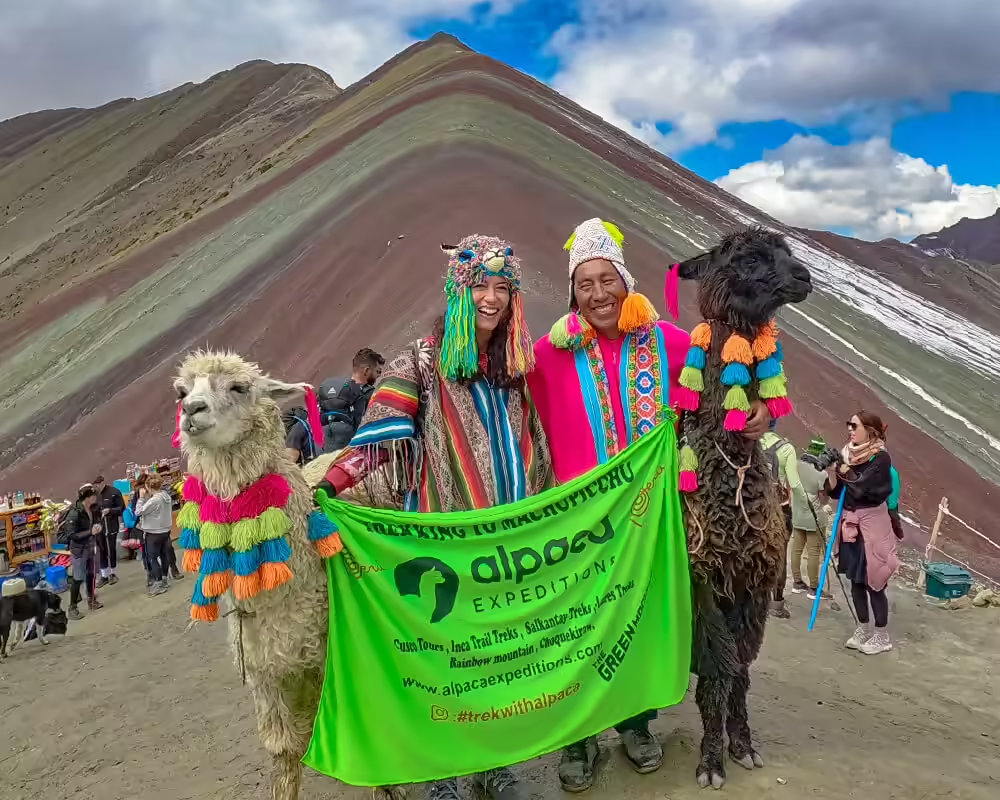
Inca Trail Hike 4D/3N & Rainbow Mountain + Red Valley 1 Day
- 5 Days / 4 Nights
- Up to 8
- Challenging
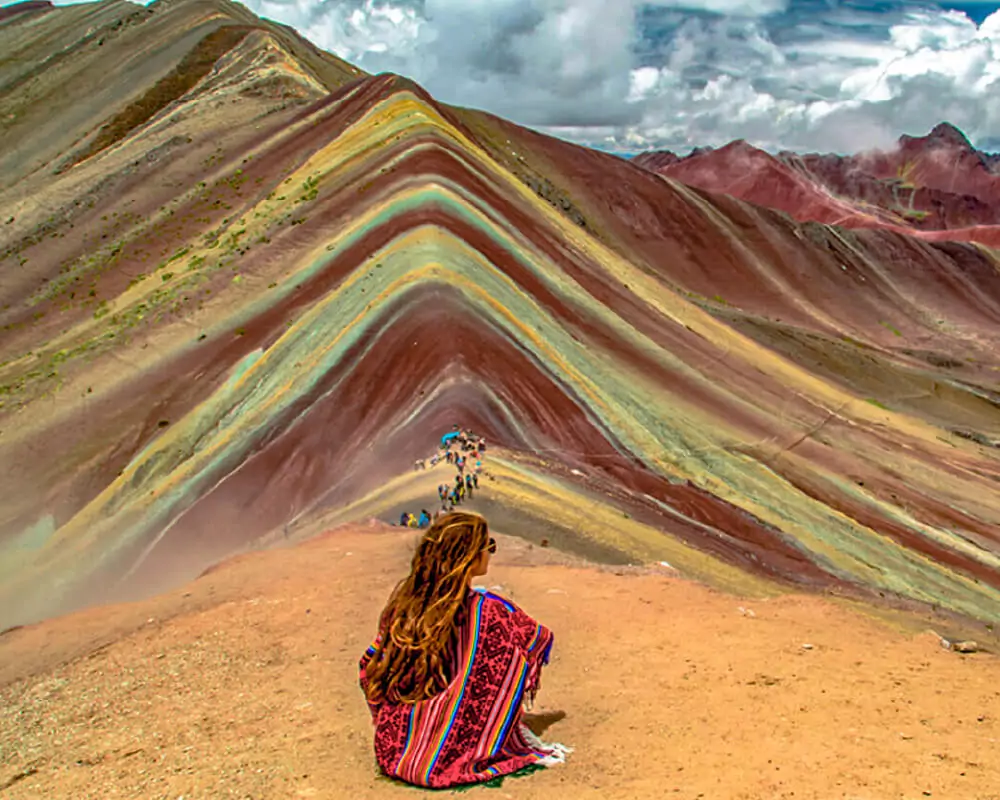
Inca Trail Hike 2D/1N & Rainbow Mountain + Red Valley 1 Day
- 3 Days / 2 Nights
- Up to 8
- Challenging
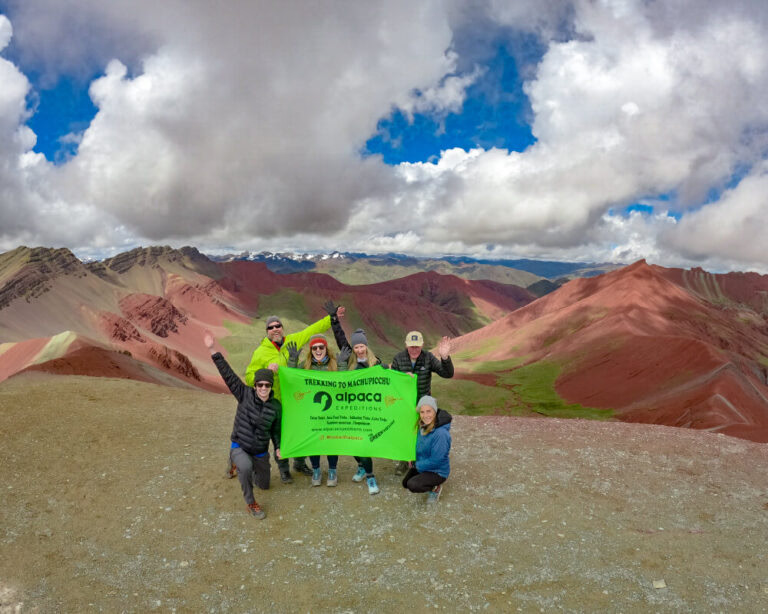
Sacred Valley Tour 1 Day & Inca Trail 2D/1N & Rainbow Mountain + Red Valley 1 Day
- 4 Days / 3 Nights
- Up to 8
- Challenging
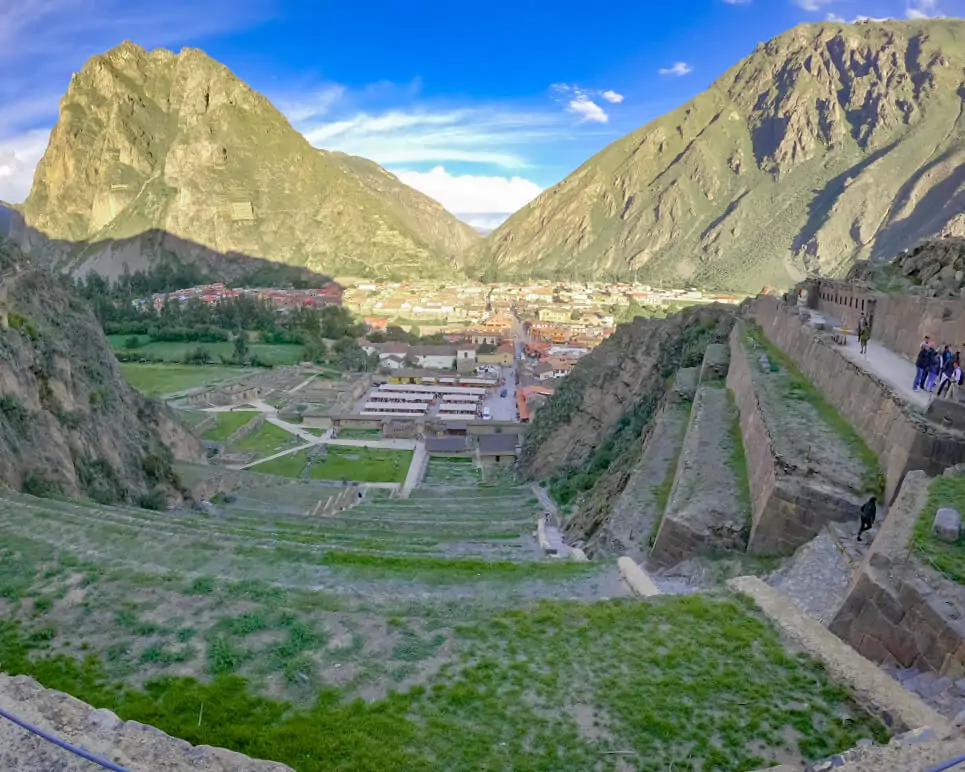
Sacred Valley Tour 1 Day & Inca Trail Hike 2D/1N
- 3 Days / 2 Nights
- Up to 8
- Challenging
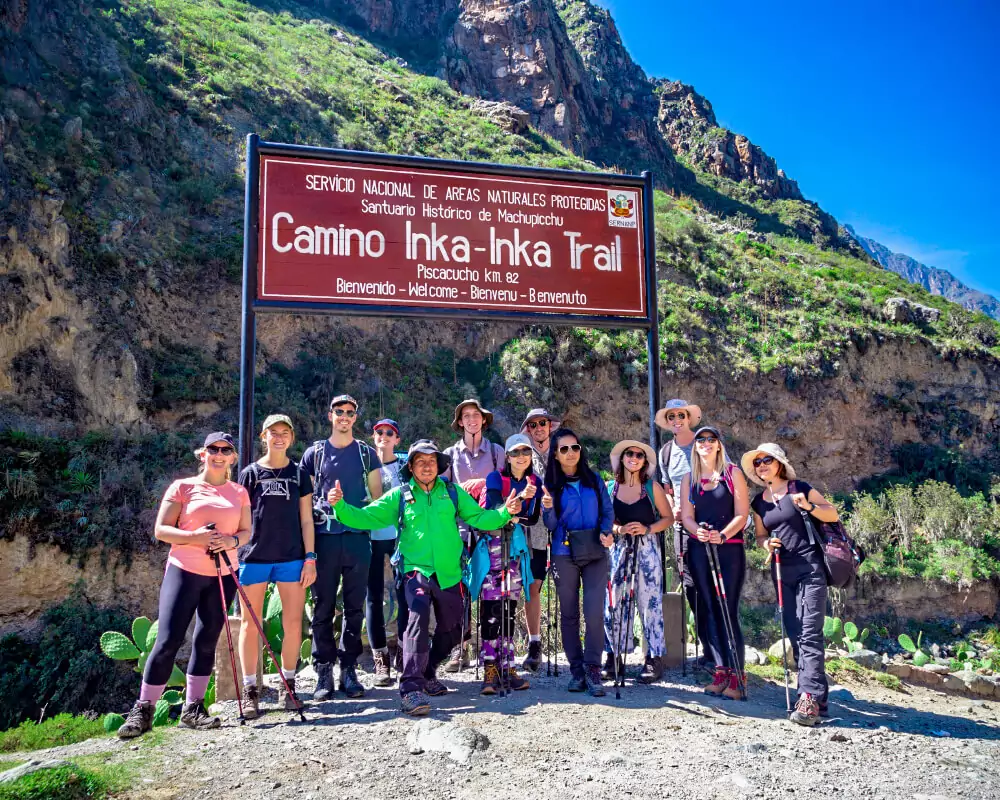
Inca Trail (Classic) 4D/3N Group Tour
- 4 Days / 3 Nights
- Up to 16
- Challenging
8. How do i book an Inca trail trek?
You can only book an Inca Trail Trek with a tour operator licensed to operate tours on the Inca Trail in Peru. The tour operator will reserve your trek dates and will secure the Inca Trail Permits necessary to hike on the Inca Trail. You first fill out a booking form that includes all details for you, and for any travelers going with you if you have a group. You will pay a $200 deposit per person. The deposits can be paid separately, as long as we have one booking form that we can use to track payments. Once we have all deposits and details, we will then book your permits. When permits are in our hands, we will send you your invoice and confirmation that everything is 100% set. All start dates, once confirmed, are guaranteed. We try to make booking as easy as possible at Alpaca Expeditions.
9. What is the difference between a private and group tour?
Essentially the tours are exactly the same, but the private tour will only be your family and friends. Group tours include people from everywhere and all varieties of hiking abilities. Private tours also receive a free air matt rental.
10. Can we pay the remaining balance for the trip using a credit card when we arrive in cusco? or do we have to pay in cash?
We strongly prefer all balances to be paid in CASH, either US or Peruvian currencies are accepted. Here in Cusco everything is done with cash – all salaries are paid in cash for our guides, porters and chefs and all logistics are paid in cash. But we understand that carrying so much cash is a concern when travelling. We are now able to accept most major credit cards at our office. This includes Visa, Mastercard, American Express. Please understand that credit card companies make it very expensive for us to process these cards, so we do charge a fee of 5% per transaction.
You can also do your payments through PayPal and we can assist you along the process.
11. How do permits work for hiking the Inca trail? do you need a permit?
The challenges of overcrowding, erosion concerns and overtourism over the last several decades have required protection for the Inca Trail. Thankfully, these protections of limiting daily trekkers and visitors preserve the ancient Inca Trail itself and historic Machu Picchu. They do also make it more competitive to get the dates you want for your trip.Only licensed Inca Trail tour operators like Alpaca Expeditions can obtain permits from the government. To learn about the complete permit process, check out Inca Trail Permits – How Permits Work and Why You Need Them In Peru.
12. Updating passport numbers before your Inca trail trek
The government will only allow us to change passport numbers if we have a copy of the new passport and old passport. If you no longer have your old passport, any government issue ID will be accepted, as long as the name is the same. Also, make sure your passport does not expire six months or less from your trip.
13. How to get to Cusco, Peru
Most people will get to Cusco by air. Please remember that the Cusco airport is for domestic travel only. If you come directly from overseas through Lima, you must get your bags in Lima and re-check them for your flight to Cusco. Four airline carriers fly roundtrip between Lima and Cusco. That includes LATAM Airlines, AVIANCA Airlines, Star Peru, and Peruvian Airlines. They all offer similar schedules and in-flight service, but we usually recommend either LATAM airlines or AVIANCA. They tend to be the most helpful when unexpected flight cancellations or delays occur.
14. How do i get from the airport to my hotel? or, how can i find the person who is picking me up at the airport?
Upon arrival at the Cusco airport, you will be directed to exit by the baggage claim area. You will need to exit outside from baggage claim and into the airport´s parking lot to find your Alpaca Expeditions transfer. Our team is ready for your airport pick-up if you requested a pickup. They will be holding a sign with your names on it for easier identification. Look for our trademark bright green Alpaca Expeditions uniforms.
Should there be any last-minute changes to your arrival flight details, please CONFIRM these changes to us AS SOON AS POSSIBLE. Our office numbers are as follows:

Mobile:
+51 947 824774
+51 986 029262
15. Where to stay in Cusco, Peru
While you can stay at any hotel in Cusco, the city is becoming more challenging to navigate by car. Many roads, especially near the main square, are open to pedestrian traffic only. We will notify you if it is not possible to pick you up by car and arrange another meeting point for pick up/drop off. For a list of recommended hotels in Cusco, with 3-Star, 4-Star and 5-Star rankings, see Where to Stay in Cusco When Hiking the Inca Trail.
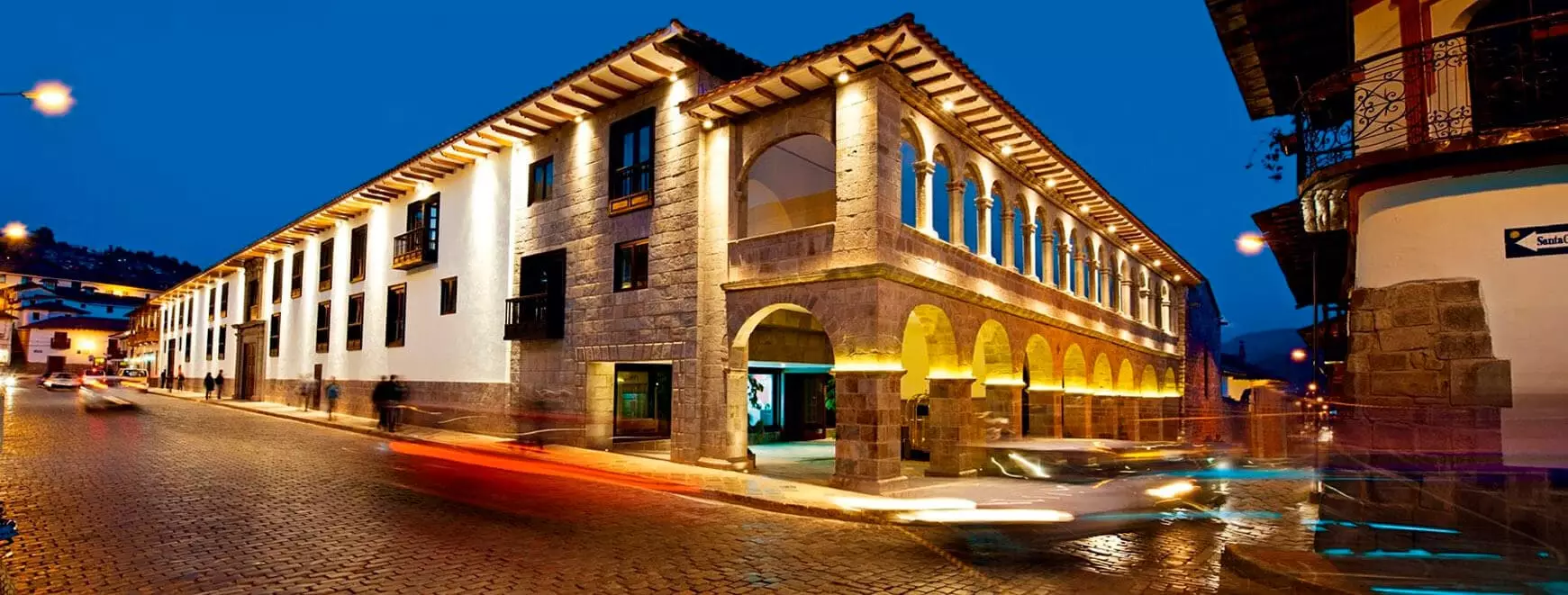
16. Can i stay in the Sacred Valley, Peru instead of in Cusco?
Ollantaytambo is the best place to stay other than Cusco. At 9,160 feet, it is a great option for acclimatizing to elevation, compared to Cusco at 11,152 feet. Also by staying in Ollantaytambo you get a little more sleep, as we will pick you up about 1.5 hours after the Cusco pick up time. You can only have your briefing in Cusco. So please arrange a time that works for you and our office team with your Alpaca Expeditions sales rep.
17. Can i spend an extra night in Aguas calientes, Peru?
Of course, if you are ok with taking the same train out of Aguas Calientes that is part of your original itinerary, which is typically at 4:22 that evening, then there is no additional charge to move the train back a day. If you need us to secure your hotel or another visit to Machu Picchu, this will be an additional cost. If you do choose to spend one more night in Aguas Calientes (the town at the entrance of Machu Picchu), make sure you tell the Alpaca Expeditions office at least one month in advance, so your train ticket is purchased for the right day.
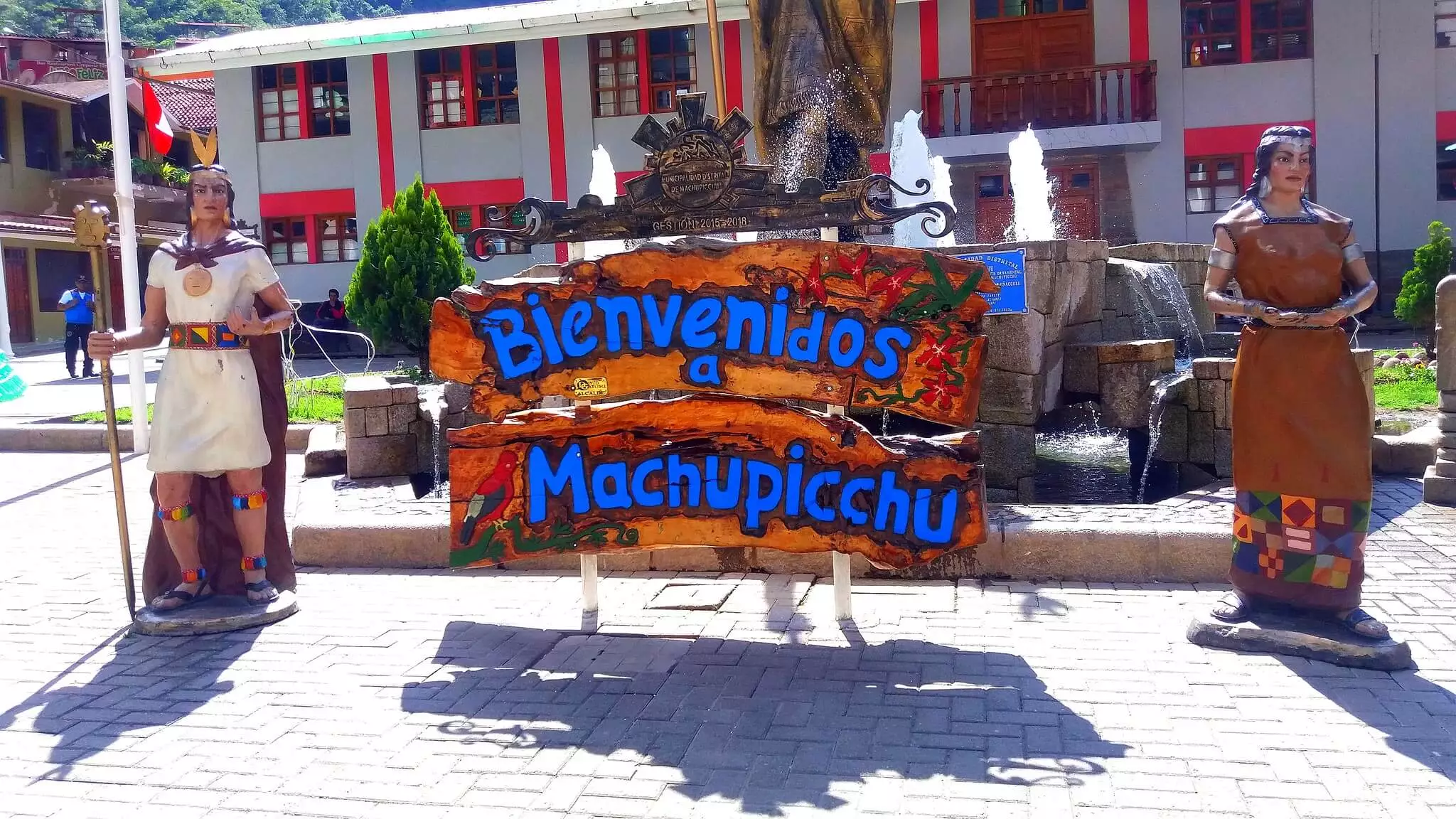
18. What is Huayna Picchu mountain and where is it?
The Huayna Picchu Mountain is that gorgeous, picturesque mountain peak that is tucked up against the Machu Picchu ruins in all the best photos and postcards. Once you get to Machu Picchu, you have the opportunity to go beyond the basic tour of the Machu PIcchu ruins and also hike up the Huayna Picchu Mountain, next to the ruins. This hike will give you breathtaking views of the forests and valleys surrounding this ancient site as well as an aerial view of Machu Picchu ruins that is spectacular and cannot be seen any other way.
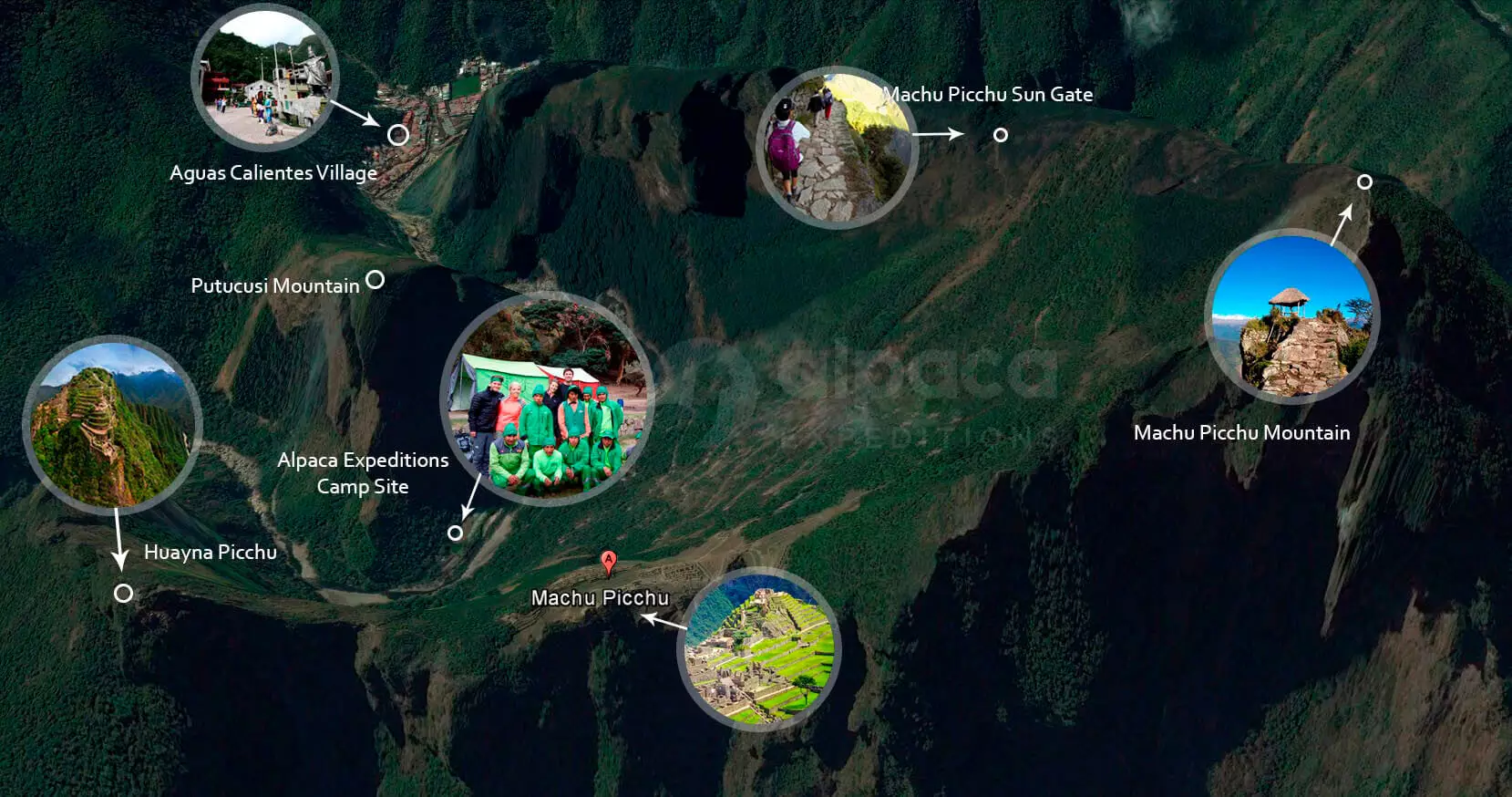
19. What is the Huayna Picchu hike?
The Huayna Picchu hike is climbing up a steep, long set of stone steps carved into the mountain side. The Huayna Picchu Mountain is 2700 meters/ 8858 feet. There is a cable to hold onto as you climb up the steps. The hike up Huayna Picchu is a truly challenging climb, and you’ll have 2 hours to do it. Permits are required and climbing times are specified on your ticket. You want to add on a ticket to climb Huayna Picchu when you reserved your trip to Machu Picchu, or as soon as you know you want to climb it. IT’s a very popular climb and tickets do sell out. Learn more about hiking up Huayna Picchu Mountain, also called Wayna Picchu.
20. Do most people do the Huayna Picchu mountain hike at Machu Picchu?
Yes, almost 80% of our guests want to add the Huayna Picchu hike because the views and vantage point looking down on Machu Picchu is simply the best in the world. Tthe other 20% are typically not able to because of health, age or preferences. Some will hike nearby Machu Picchu Mountain instead, a longer but less steep hike up another mountain that looks down on Machu Picchu. Get more information on Huayna Picchu Mountain here.
21. Do i need a tour operator or a guide for the Inca trail?
Yes! It is now illegal to hike the Inca Trail without an operator and has been like that since 2000. In order to hike, you need a permit, which only licensed operators can get – so you need to be specific. Other trails in the Andes can be done without a guide, but the Inca Trail can only be done with a licensed guide from a licensed tour operator. Learn more about why Permits and Guides are required on the Inca Trail and how the Inca Trail Permit System works.
WEATHER, SEASONS, AND RAINFALL ON THE INCA TRAIL
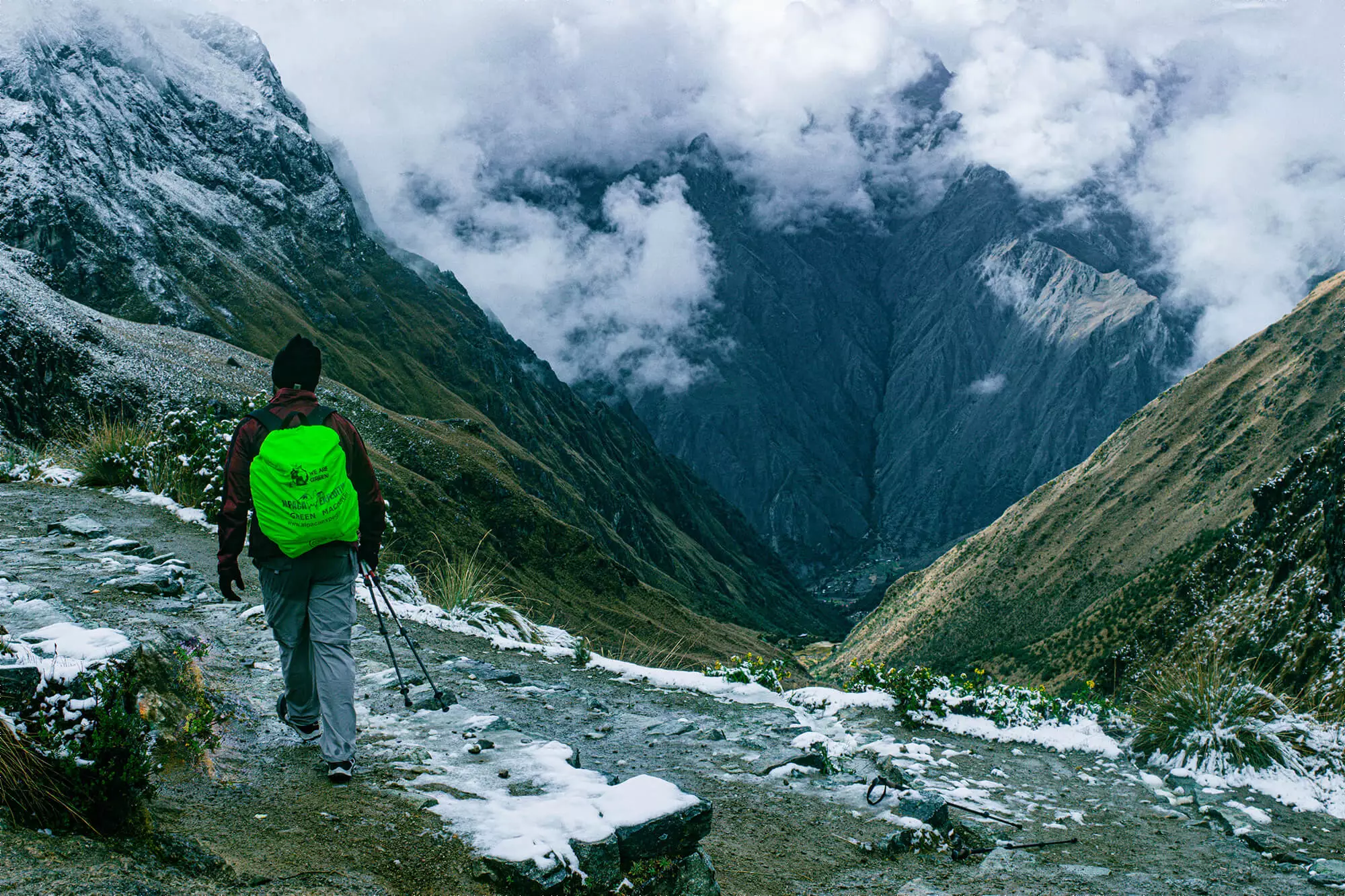
22. What will the weather be like on the Inca trail?
The weather on the Inca Trail depends on the season. Historically, April through September is the dry season, November through February is the rainy season, and March and October are bridge months – a mixture of both. Peru is in the southern hemisphere, so when its summer in NOrth America, it is winter in Peru. The months of June – August are peak winter in Peru, and November – February are considered summer, or because of Peru’s climate in the Machu Picchu region, it is also called the rainy season. However, weather has become more variable in the last few years. It is best to prepare for sun and rain no matter when you come. As far as temperatures go, that is consistent throughout the year. Mornings and evenings are always cold. Make sure to bring a fleece jacket for the mornings and a down jacket for the evenings. Once the sun is up you should be comfortable hiking and touring Machu Picchu in short sleeves. Long pants (yoga or hiking) are encouraged to help from the mosquitos which can be a nuisance in Aguas Calientes. Read about general weather trends for each trekking trip here.
23. What are the average monthly temperatures on the Inca trail?
Here are the monthly max and min temperatures on the Inca Trail in degrees Celsius and Fahrenheit:
| MONTH | AVG HIGH Celsius | AVG HIGH Fahrenheit | AVG LOW Celsius | AVG LOW Fahrenheit |
|---|---|---|---|---|
| JANUARY | 14.7 °C | 58.4 °F | 8.5 °C | 47.4°F |
| FEBRUARY | 14.6 °C | 58.3°F | 8.6 °C | 47.5°F |
| MARCH | 14.8 °C | 58.6 °F | 8.5 °C | 47.3°F |
| APRIL | 14.7 °C | 58.4°F | 7.8 °C | 46.1°F |
| MAY | 14.3 °C | 57.8 °F | 7 °C | 44.6°F |
| JUNE | 13.8 °C | 56.9 °F | 5.9 °C | 42.6 °F |
| JULY | 13.6 °C | 56.4 °F | 5.2 °C | 41.3 °F |
| AUGUST | 14.1 °C | 57.4°F | 5.6 °C | 42 °F |
| SEPTEMBER | 14.5 °C | 58.1°F | 6.5 °C | 43.7 °F |
| OCTOBER | 15 °C | 59.1°F | 7.6 °C | 45.7 °F |
| NOVEMBER | 15.2 °C | 59.4°F | 8.4 °C | 47.2 °F |
| DECEMBER | 14.9 °C | 58.8 °F | 8.7 °C | 47.6 °F |
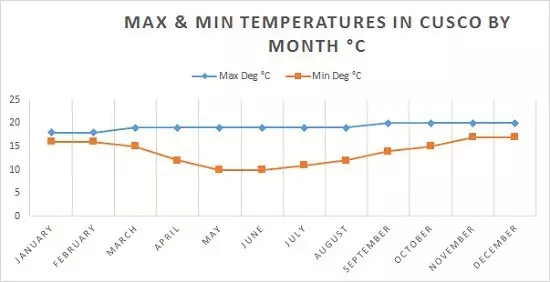
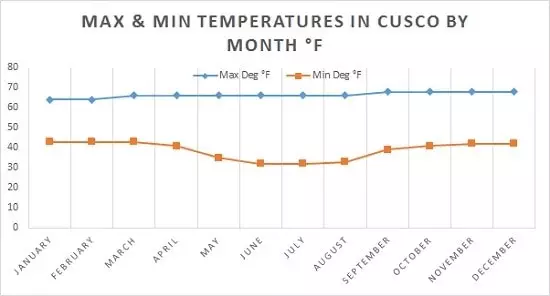
24. What is the average monthly rainfall on the Inca trail in inches/mm?
Here are the monthly average rainfall on the Inca Trail in inches and millimeters (mm):
| MONTH | AVG RAINFALL in | AVG RAINFALL mm |
|---|---|---|
| JANUARY | 6.25 in | 160 mm |
| FEBRUARY | 5.125 in | 140 mm |
| MARCH | 4.125 in | 110 mm |
| APRIL | 1.9 in | 45 mm |
| MAY | 0.2 in | 10 mm |
| JUNE | 5 | 20 mm |
| JULY | 0.125 in | 6 mm |
| AUGUST | 0.5 in | 10 mm |
| SEPTEMBER | 1 in | 20 mm |
| OCTOBER | 1.95 in | 50 mm |
| NOVEMBER | 3 in | 80 mm |
| DECEMBER | 4.8 in | 120 mm |
PACKING FOR YOUR TREK ON THE INCA TRAIL
26. Where do you store luggage while you’re hiking on the Inca trail?
All of your luggage is not needed for the trek and should stay in Cusco. All hotels are very accommodating and quite used to storing luggage on-site, or you can safely store with the Alpaca Expeditions team. Learn more about storing your luggage while you hike the Inca Trail.

27. What do i need to pack to trek/hike the Inca trail?
Here is an example list. Read our detailed ultimate packing list guide for hiking the Inca Trail to see recommended amounts and types of items. Also, see what equipment and gear is available for rent for hiking the Inca Trail, so you can reduce what you have to pack and bring to Peru.
- Sport, moisture-wicking underwear
- Base layers
- Trekking T-Shirts (LS and SS)
- Trekking shorts or pants
- Fleece jacket and windbreaker
- Warm jacket (for nights)
- Rain gear or poncho
- Hat
- Sunglasses
- Headlamp
- Gloves
- Walking sticks (available for rent)
- Boots or hiking sandals
- Trekking socks
- Gaiters (optional)
- Day pack
- Water bottle
- Hydration pack
- Sleeping bag (available for rent)
- Sleeping bag liner (available for rent)
- Air mattress (available for rent)
- Inflatable pillow (optional)
- Ear plugs (optional)
- Passport
- Insurance
- Trekking Towel (optional)
- Swimsuit (optional – for hot springs on some treks)
- Water-proof sunscreen
- Bug spray
- Baby wipes
- Plastic bags
- Blister care
- General meds
- Snacks
- Toiletries
- Cash
- Camera
- Power bank/battery charger for any electronics like smart phones/cameras.
To get a complete understanding of what type of gear you’ll need to pack and what’s available for rent, check out Ultimate Peru Trekking Packing List and see what gear Alpaca Expeditions offers.
28. What do i need to carry in my daypack on the Inca trail?
Porters will be responsible for carrying all your overnight supplies in your duffel to each campsite, but everyone must have a day pack that should include everything you need/want for hiking during the day, since your duffel will only be available in the morning and evening.
Here are the typical items you will want to carry in your daypack: raincoat, sweater and/or jacket, water bottle, flashlight, insect repellents, sunblock, antiseptic hand gel, water bottle or hydration pack, any needed toiletries or meds, and a backup stash of toilet paper. You might also want to carry snacks, biscuits, and dried fruit. Alpaca Expeditions will provide you with some snacks. And don’t forget your camera!
29. What should i pack if i am doing a 2 day trek?
The 2 Day treks on the Inca Trail are very different from 4-7 day trips. On the 2 day trip, you will have one day of hiking, and one day at Machu Picchu. You will also be carrying all of your own items for this trip. Please pack as light as possible – bring only the essentials.
30. Do i need hiking boots to trek the Inca trail?
We always recommend light hiking boots if possible. Ones with ankle support are extra helpful, especially for the inexperienced hiker. Because you will be climbing down so many steps created by the Incas, now uneven and at varying heights, the extra support helps from twisting your ankles. Be sure to break in any new boots well before your trip!.
31. Should i use walking sticks on the Inca trail?
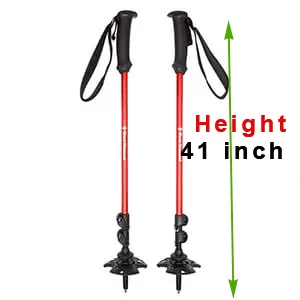 Walking sticks are always helpful to trekkers, but particularly on this trek. The Inca Trail footpath is filled with many stone stairs that you will walk up and down. They were all hand carved and laid by the Incas, 400 years ago. They vary in height and are not all straight. Using walking sticks can help take the pressure off your knees while doing this portion of the trail. Plus, they will help you get up the mountain as well. All our walking sticks are expandable black diamond poles that can be collapsed smaller and tied to your bag when you are not using them.
Walking sticks are always helpful to trekkers, but particularly on this trek. The Inca Trail footpath is filled with many stone stairs that you will walk up and down. They were all hand carved and laid by the Incas, 400 years ago. They vary in height and are not all straight. Using walking sticks can help take the pressure off your knees while doing this portion of the trail. Plus, they will help you get up the mountain as well. All our walking sticks are expandable black diamond poles that can be collapsed smaller and tied to your bag when you are not using them.
Metal tips on your hiking poles are not allowed on the Inca Trail. For those who are bringing their own walking poles, make sure you have rubber tips, or the rangers will not allow you to use them. Rubber tips can be purchased in Cusco if you forget to change out your metal tips, before you arrive in Cusco. Also – note that airlines will not let you fly with walking sticks in your carryon luggage, you must check them in your bags. Check and be sure you can even bring them at all. Walking poles/sticks are available for rent by Alpaca, so you don’t actually have to hassle with bringing them on flights if you don’t want to.
32. What is the temperature rating of Alpaca Expeditions sleeping bags, liners, and sleeping pads available for rent?
Our Inca Trail “sleep System” includes a sleeping bag, sleeping bag liner, and several types of sleeping pad. We use mummy style sleeping bags that are usable in -15° C / 5° F. Please note that if you are over 1.95 meters / 6’4″ tall, you won’t be able to find a sleeping bag rental in Cusco. In this case, it is recommended to bring your own. We provide cotton liners to everyone that are machine washed between every use. These do need to be included in your duffel weight. Some guests will rent our sleeping bags and bring their own lightweight sleeping bag liner.
A foam mat is included to separate and insulate you from the ground. For added comfort, you may want to consider upgrading, by renting an inflatable sleeping pad, which adds three inches of comfort on top of the provided foam mat. (You will use both.) We use Thermarest and Eureka inflatable air mattresses.
33. Is there any location where we can plug and charge our electronic devices on the Inca trail?
There is an electricity facility at the last campsite on the Inca Trail. But, there could be a very packed line to use it as there is only one plugin source, so we recommend taking extra battery packs or power bans with you. See examples of portable battery packs / power banks.
35. What size day pack is allowed into Machu Picchu?
We encourage you to take seriously the kind of daypack you’ll purchase. Fashion doesn’t matter, in the trail find a trekking daypack and pay attention to the features:
• Size: Machu Picchu regulations only allow a max of 25L backpacks. If you exceed this 25L limit, the rangers will ask you to store your backpack during your guided tour. Remember that your porters will carry 7 kgs for you, so try to pack light.
•Waterproof: Your backpack needs to be waterproof, most of them aren’t, so this feature is vital.
• Design: Multi-size and adjustable backpacks are needed. Check that they fit your body without restricting your movement or harming your shoulders and hips. The best manufacturers, like Osprey and North Face, design specific bags for women. They have reshaped hip belts that are wider, more moulded, and narrower, but broader shoulder straps.
Scroll to the ‘Backpacks and Daypacks’ section of the Ultimate Packing List Blog to read all details.
PHYSICAL PREPARATION FOR YOUR INCA TRAIL TREK
36. How challenging or hard is the Inca trail?
The Inca Trail is a 27-mile trek through mountainous regions and over rugged terrain. The trek is at a high altitude of up to 4200 Meters above the sea level. This is, therefore, a physically taxing exercise and you will have to be physically fit to undertake it. It is advisable that you go to the gym or walk for a couple of kilometers every day in months leading to the trek. It is also imperative that you acclimatize yourself to the altitude. You can do this by simply spending a couple of days in Cusco, which is 3400 Meters above the sea level.
Every tour operator is a little different, but the hike is usually broken down into:
- Day 1: 11 km (6.8 miles)
- Day 2: 12 km (7.5 miles) Dead Woman’s Pass is also hiked over on this day. This is the highest point on the Inca Trail, at elevation 4215 meters / 13,829 feet. Note that
this is nearly 1800 meters/ 5905 feet HIGHER than Machu Picchu! That’s more than a mile higher in elevation than Machu Picchu! - Day 3: 16 km (10 miles)
- Day 4: 4 km (2.5 miles) The Last City of the Incas – Machu Picchu – is visited on this day. It’s a short hike through the famous Sun Gate in the early morning, into Machu Picchu! Then you will spend several hours exploring Machu Picchu with your guide.
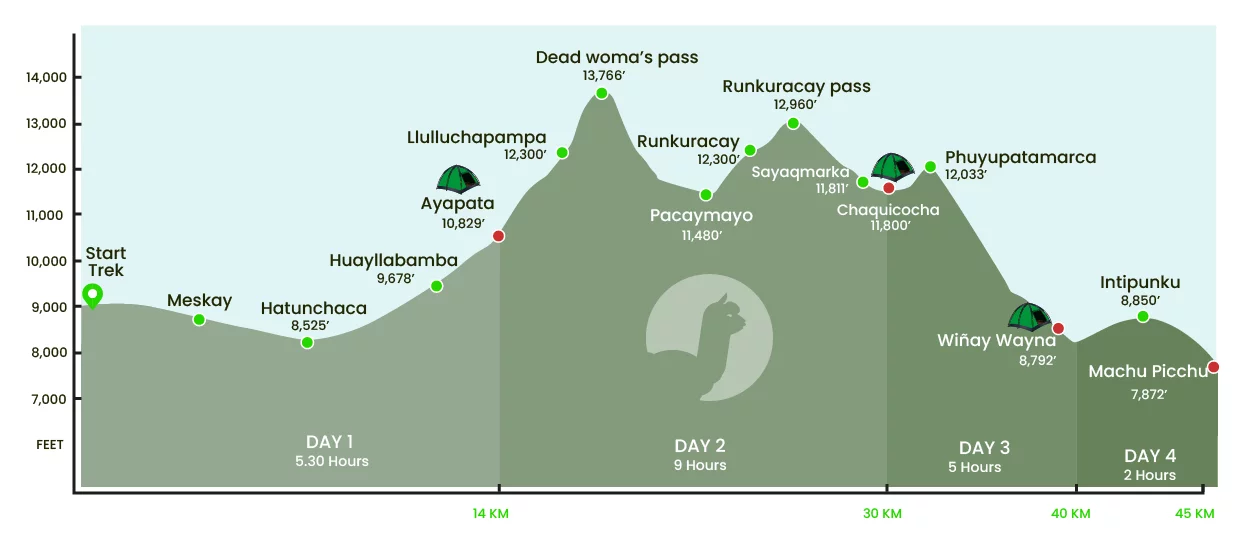
NOTE: If you are hiking the Classic Inca Trail in 5 days, instead of 4 days, you will do the same route, but shorter mileage each day!
37. What is the elevation gain on the Inca trail hike?
The total elevation climbed and descended on the Inca Trail in Peru is almost 6000 feet or 1800 meters. The Classic Inca Trail – spanning about 28 miles or 45 kilometers, ranges in altitude from the lowest point at Machu Picchu of 7872 feet/2400 meters to the highest point of over 13,700 feet/4200 meters at Dead Woman’s Pass. See a detailed elevation map here in our Guide to Hiking to Machu Picchu.
38. Is the inca trail to Machu Picchu 5d/4n the same path as the 4 day Inca trail?
Yes, it’s the same route as the shorter trek just at a slower pace, spending more time at the ruins each day. While you still get to Machu Picchu on Day 4, you will be there for sunset (hopefully good weather will let you witness this) instead of sunrise, and then you head down to Aguas Calientes for some well-needed rest and a hot shower. The next day you will be at Machu Picchu for the sunrise (again weather dependent). The best route to do with families with younger children.
39. Is there an age limit for the Inca trail?
There is not any government regulation on the age limit for the Inca trek, and we at Alpaca Expeditions don’t actually have an age requirement, specifically for children. We have seen five year-old and even two year-old kids do the hike with their families – where the parents and porters took turns carrying them!.
STARGAZING ON THE INCA TRAIL
40. What are night skies, stargazing and constellations like on the Inca trail?
The Inca Trail is in the southern hemisphere, and so the night skies will look quite different for those trekkers coming from the northern hemisphere. For those of you booked with us on one of our Alternative Treks, we have now added telescopes to our campsites (one campsite on each trek). See how the Peruvian skies differ from your sky at home.
41. What are inca trail porters, and why are they needed on the Inca trail?
Porters carry group gear and customer overnight gear when hiking on the Inca Trail, because pack animals, like horses, mules, or llamas are not allowed on the Inca Trail. The Inca Trail is regulated by the Peru government, which implemented a permit system in 2000, in order to protect the Inca Trail from damaging erosion. Learn about how porters and permit work here in Inca Trail Permits – How Permits Work and Why You Need Them.

42. Should i pay for the extra porter on the Inca trail
All treks include porters to carry all the hiking equipment which includes tents, food, dining equipment, etc. If you feel you need to, you can get a second personal porter for $100. But our treks all include the personal porter who will carry up to 7kg of their personal items at no charge, so if you follow our packing list and keep it light, you shouldn’t need an extra one.
43. Do i need to tip the porters, chefs, and guides?
Generally speaking, if the group has been pleased with the service then it is customary to tip your team. If you aren’t sure about how much to tip the porters and chef, ask your guide and he will answer honestly. And, if you have any equipment that you brought for the trek that you think you will never use again, you can gift it to our porters. You will not find harder workers anywhere!
44. What if an emergency happens on the Inca trail, or a hiker needs medical help?
The safety and comfort of both guests and the Alpaca Expeditions team is our priority on the trail. We pride ourselves on the level of precautions we take on treks through through Andes. We were the first company to introduce required satellite phones on the trail, our team receives annual safety and first aid training, and we are always mindful of weather and trail conditions. The guides on Alpaca Expedition treks carry first aid kits, oximeters, and an oxygen tank, along with satellite phones. In the event of a guest needing an evacuation, the staff will help get the person to a location where medical transport can happen. Guests are responsible for the costs of an evacuation.
Explore our safety practices and standards to better understand the proactive role we take in your experience on the Inca Trail with us!
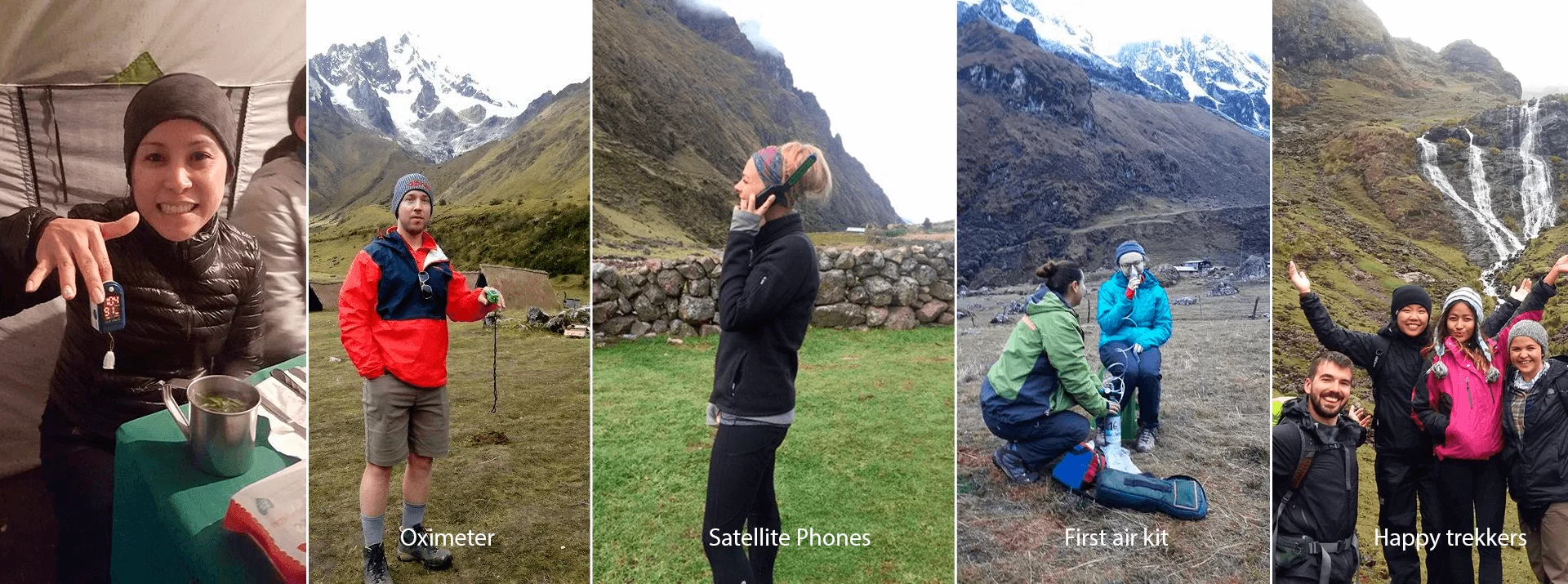
45. Where do i get clean drinking water on the Inca trail?
We supply clean water at each meal. You are responsible for bringing water for your first morning of hiking only, as we won’t have time to filter water until your first lunch. Water is filtered, boiled, then cooled each day at each meal for hikers to refill their water bottles and hydration packs for each hiking segment.
46. What will meals be like on the Inca trail
At Alpaca Expeditions, you will eat nothing but the tastiest meals prepared by professionally trained chefs! All you need to do is enjoy. Take a look at Inca Trail Treks food, nutrition, and a sample menus here.
47. Are there bathrooms on the Inca trail?
We provide private Toilet Tents that are eco-friendly with every trek. This makes your life much more comfortable and ensures your privacy as the bathrooms provided on the trail are very heavily used by all of the trekking public. They are generally not properly maintained and not in good condition. Learn more about the bathrooms on the Inca Trail.
COVID RELATED FAQS FOR HIKING THE INCA TRAIL
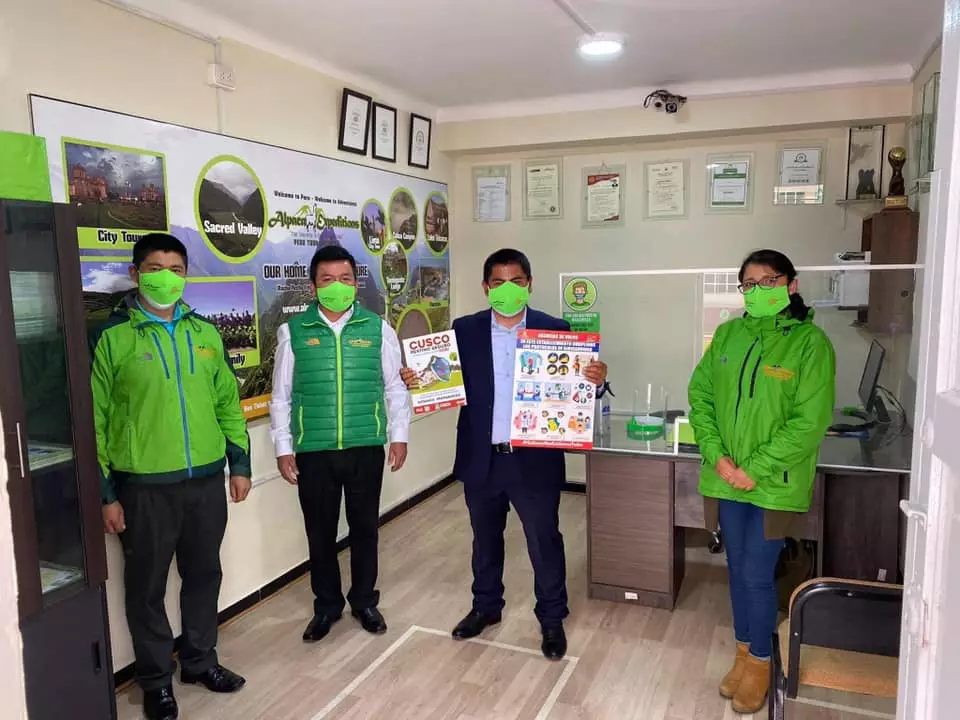

48. What are the current covid restrictions in Peru?
Currently, to visit Peru you need to have your vaccination card with the double doses completed 14 days prior to your arrival. To enter the country, the government is still allowing PCR tests, however inside the country to enter to all public spaces you’ll need your vaccination card. Double masks or KN95 masks are required to wear in all public spaces. The curfew goes from 2AM to 4AM in Cusco.
49. Can i cancel my hike? what is the cancellation policy for the new variants of Covid?
At this time our cancellation policy is that all USD $200 booking deposits (for any trek including the Inca Trail 4D trek) are non-refundable and non-transferrable. This means that once we secure your Inca Trail permit for a specific date in 2022, we cannot refund your booking deposit (or change the date). The only circumstance in which we could refund or change the date of your Inca Trail permits would be if Peruvian authorities decide to close international borders, thus allowing no foreigners into Peru or for any Covid reason the Inca Trail may close we can help you to reschedule your tour.
50. What are the current covid restrictions on the Inca trail?
Essentially, here are the current restrictions:
- Only 250 permits are released per day to the public
- This limit includes guides, porters, and other staff
- You must enter the Inca Trail with a licensed tour operator (like Alpaca Expeditions)
- Entry points and camping spots were pre-determined on your permit and at ranger-protected checkpoints.
- Permits are non-refundable and non-transferrable. Dates and names can not be moved
53. Can you help me arrange my Covid test?
Yes. If you need help with getting a COVID test to return to your country we can help you find and schedule that. The price for an Antigen test is 150 PEN and you can arrange a test with our counter representative during your check-in. The test is done at 02 Clinic Medical Network and we will provide all the assistance needed to get there.
Alpaca Expeditions Recognitions
ISO (International Organization for Standardization)
In the pursuit to stand out from the rest, Alpaca Expeditions has obtained four ISOs plus our carbon footprint certificate to date. These achievements result from our efforts to implement the internationally-recognized integrated management system. They also represent our commitment to all of our clients and staff of operating sustainability and responsibility in every way possible.


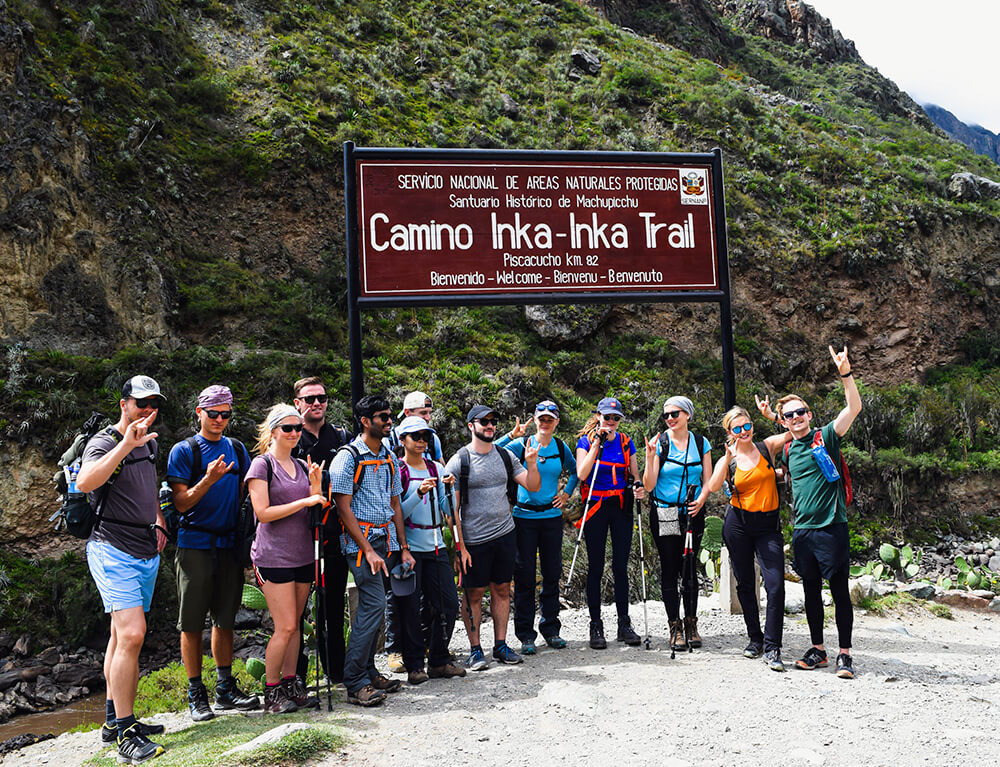
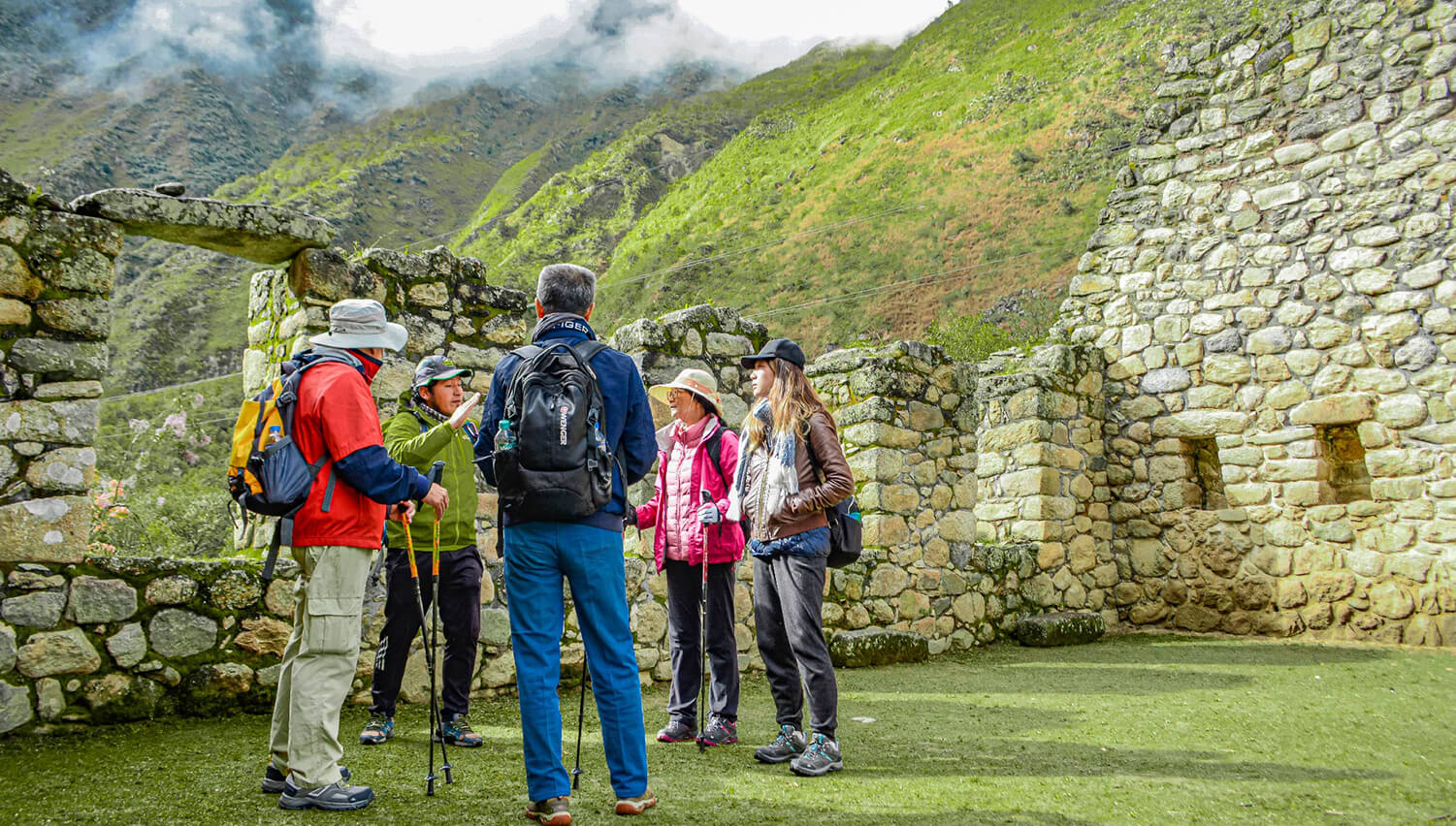
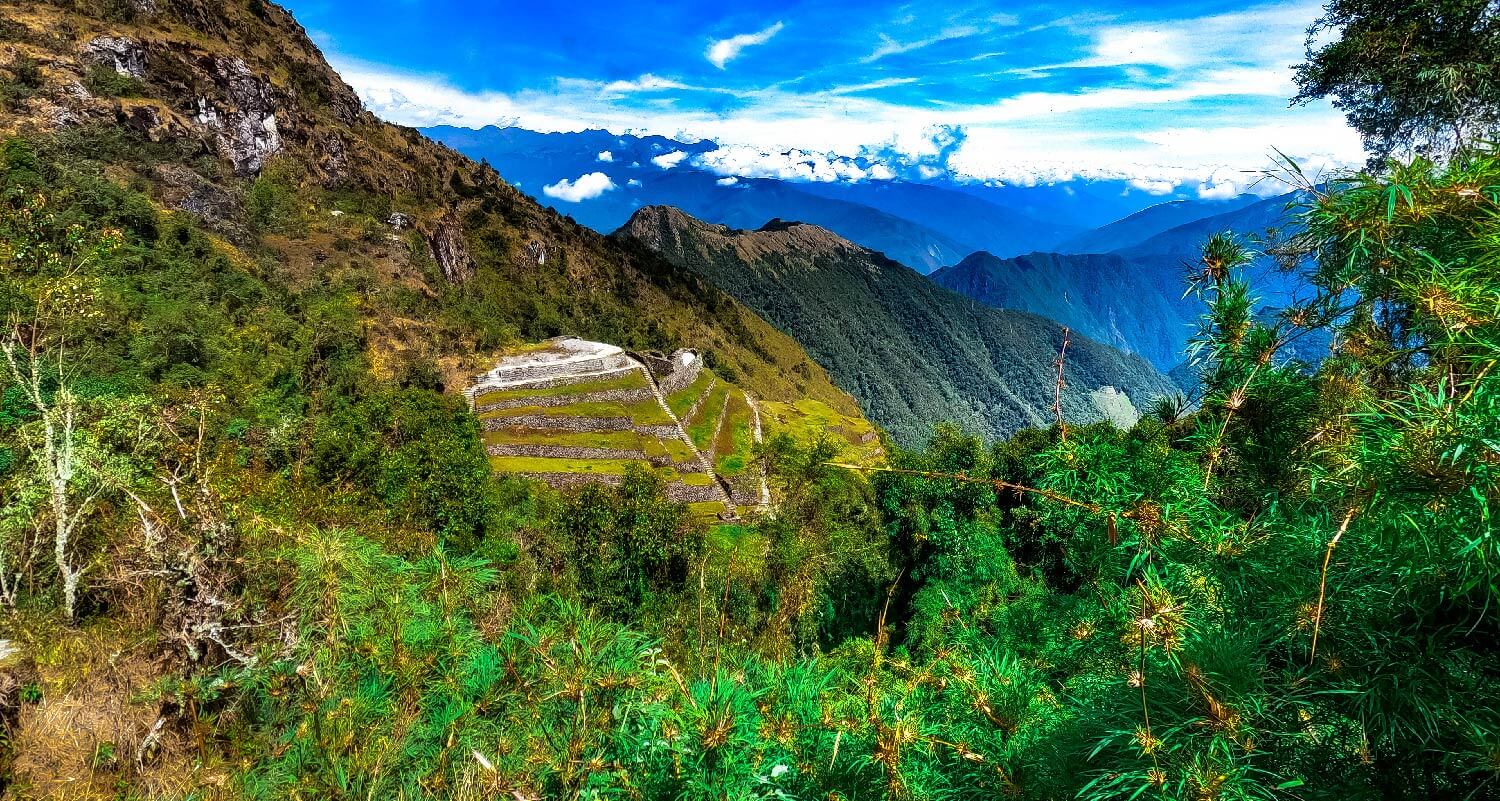
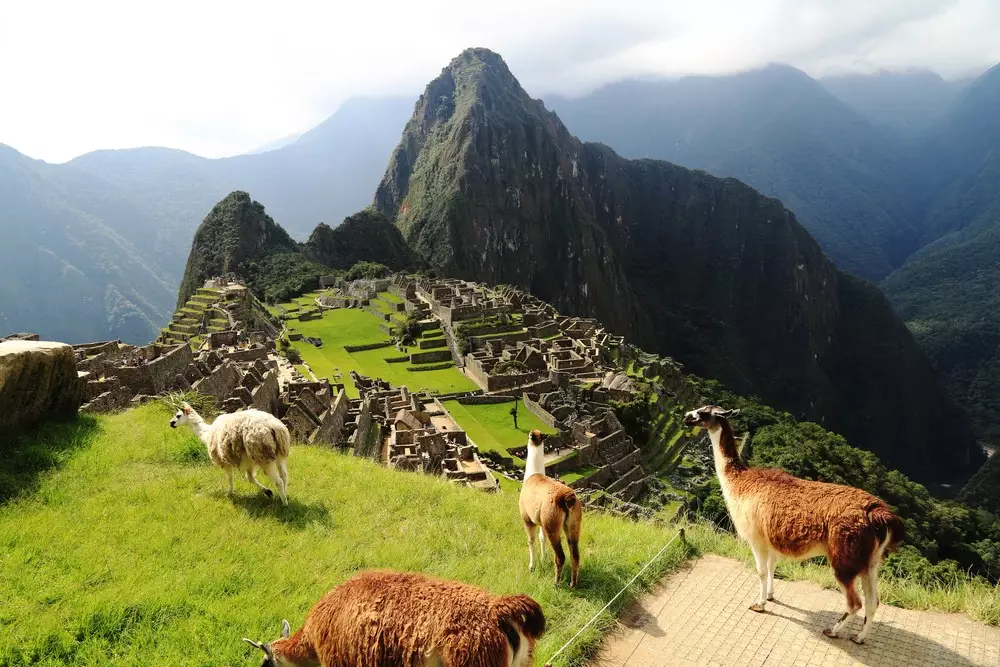
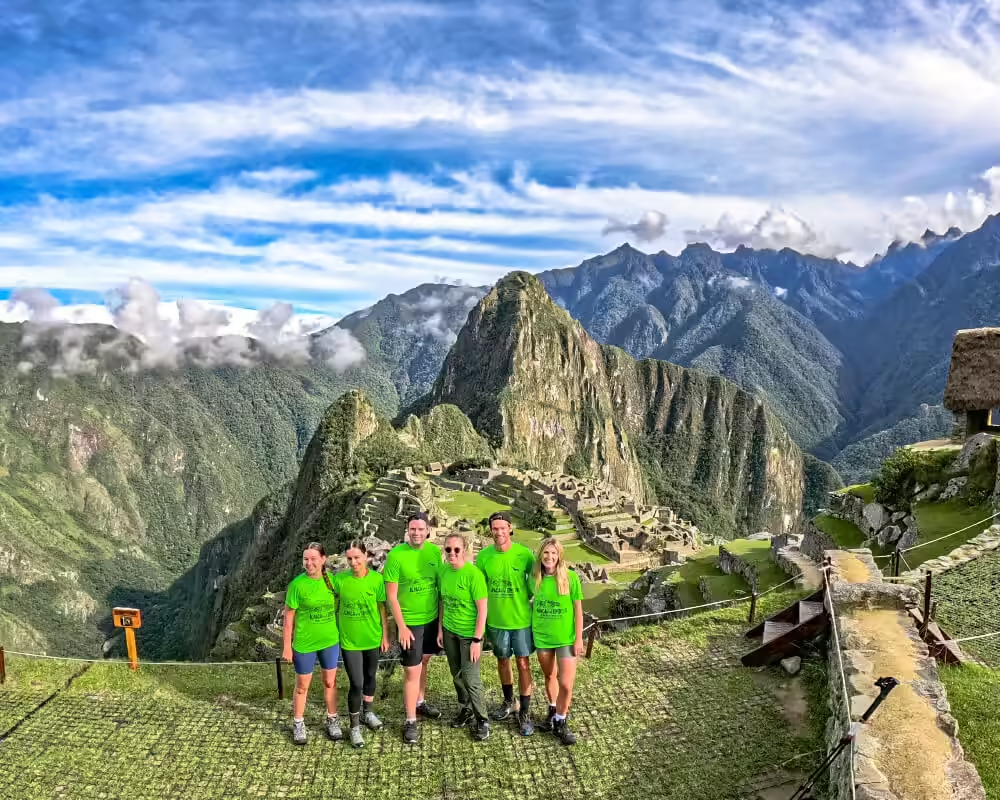
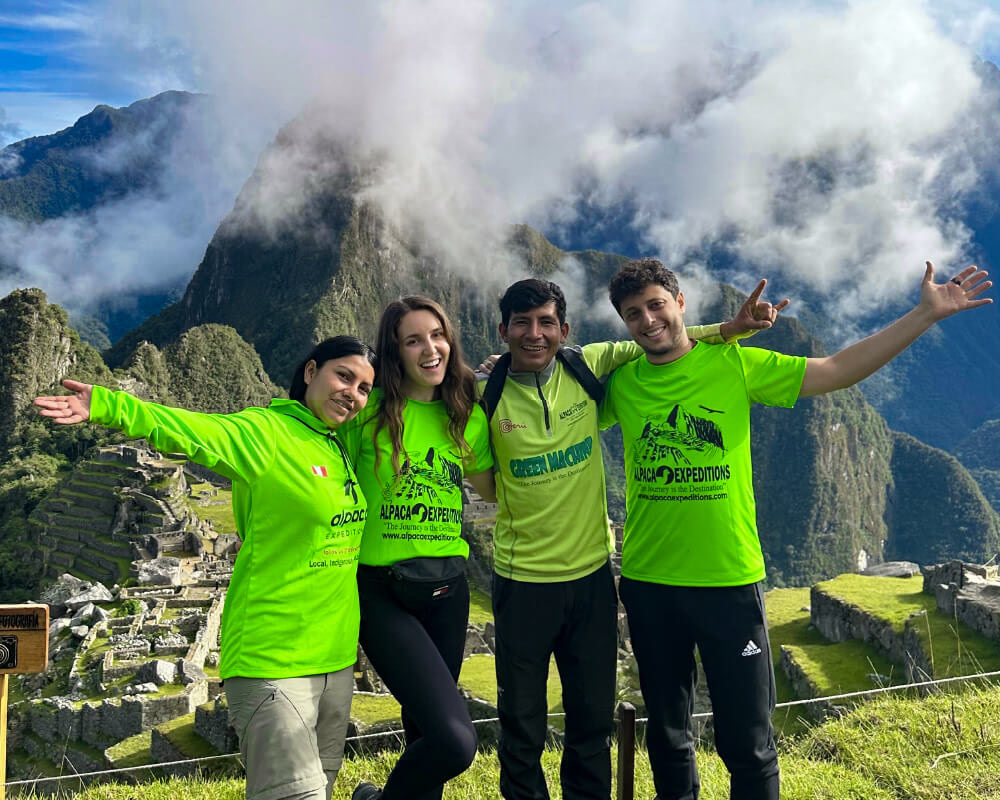
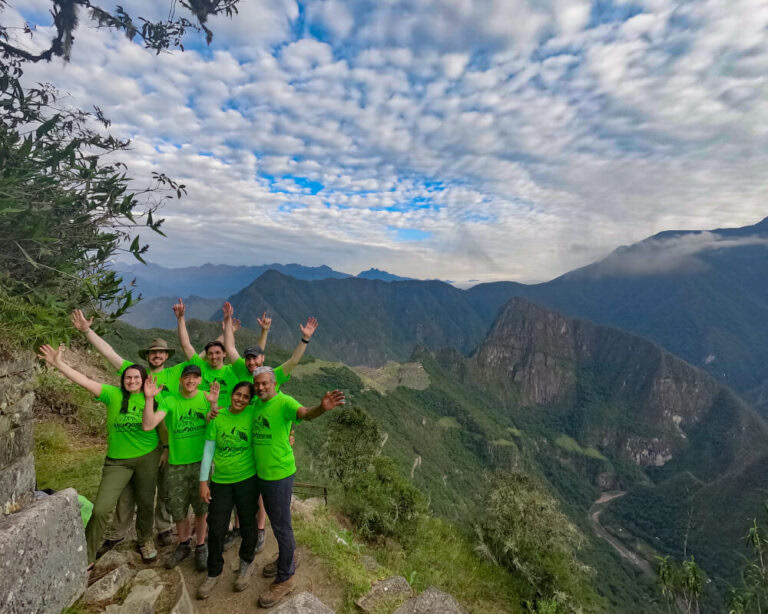
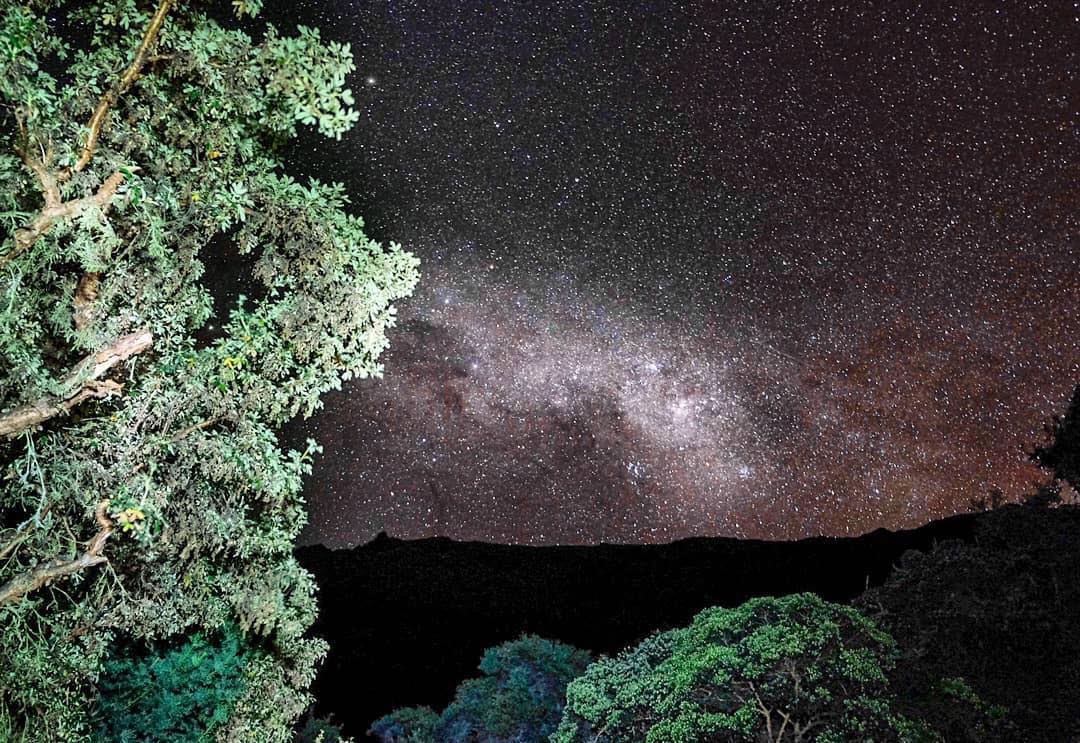

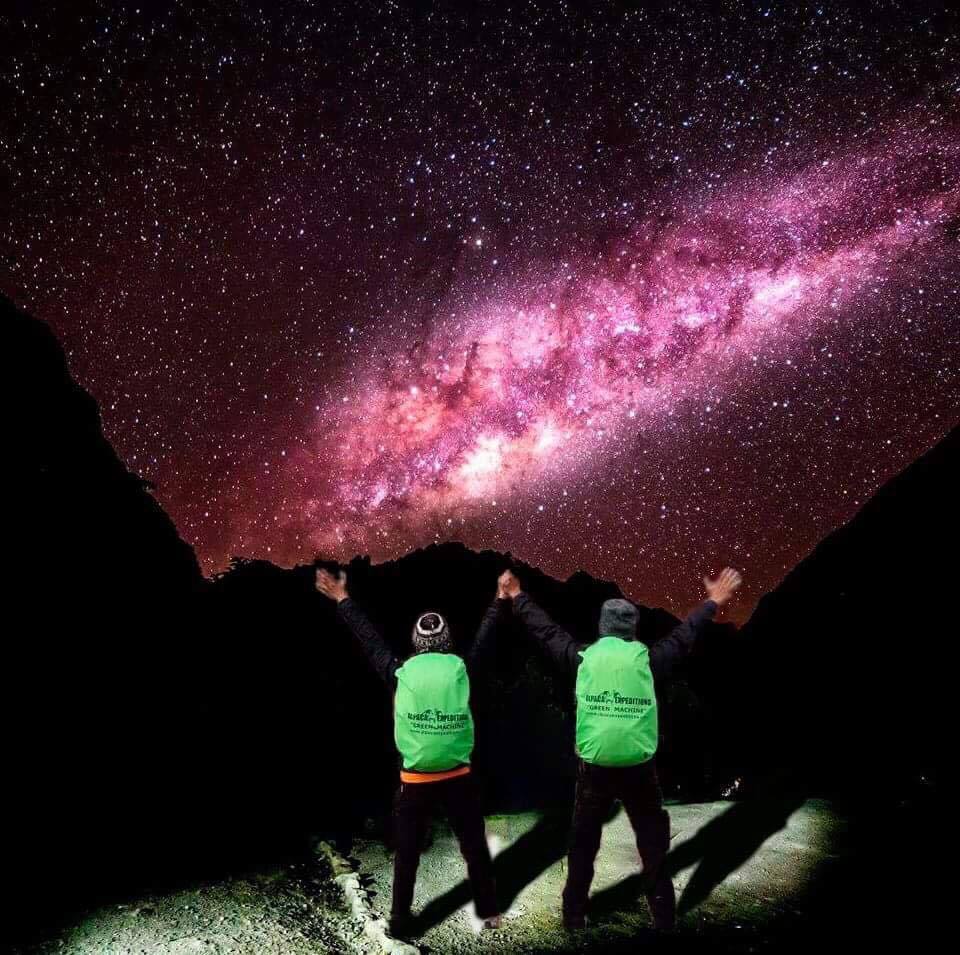
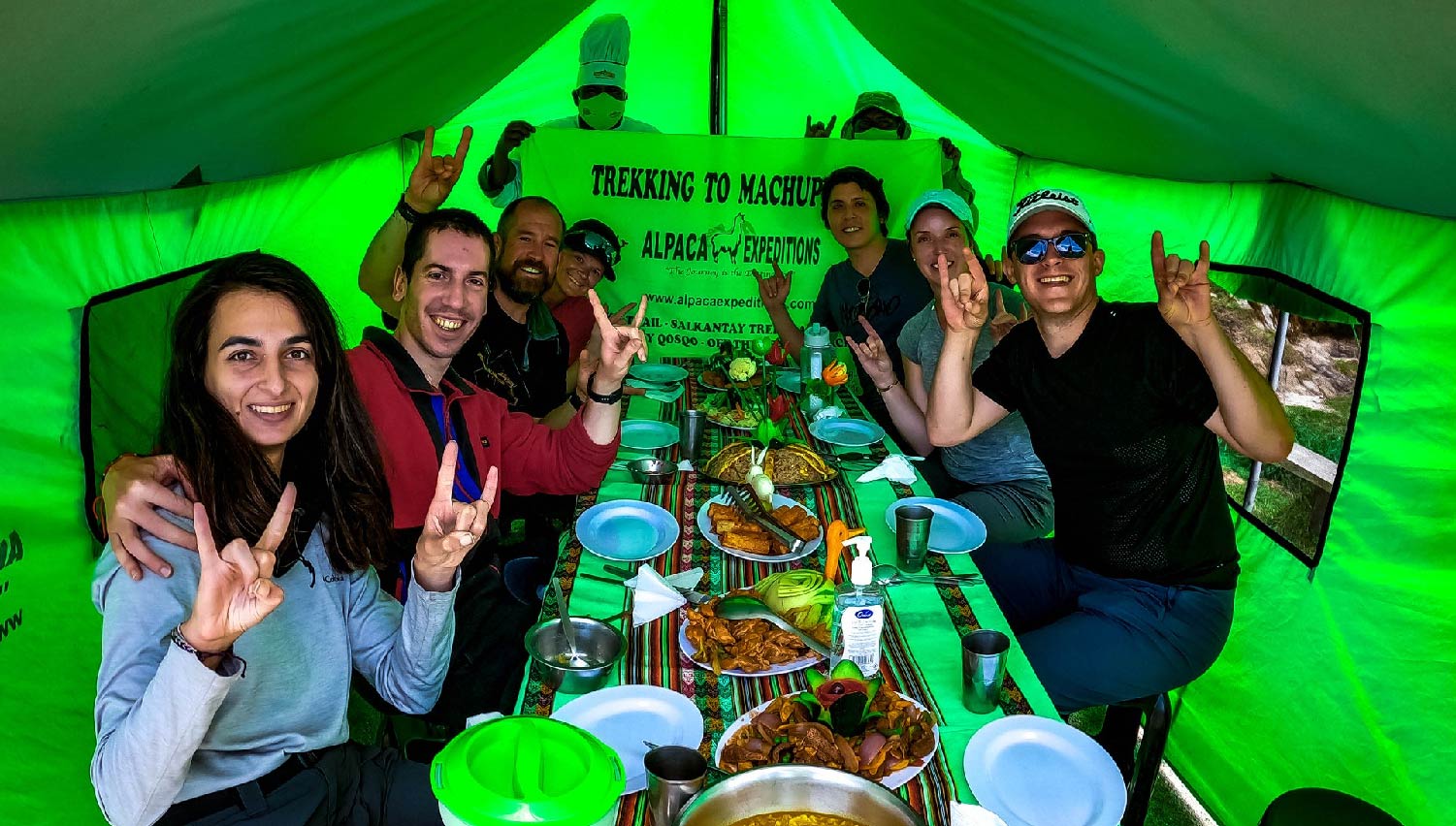
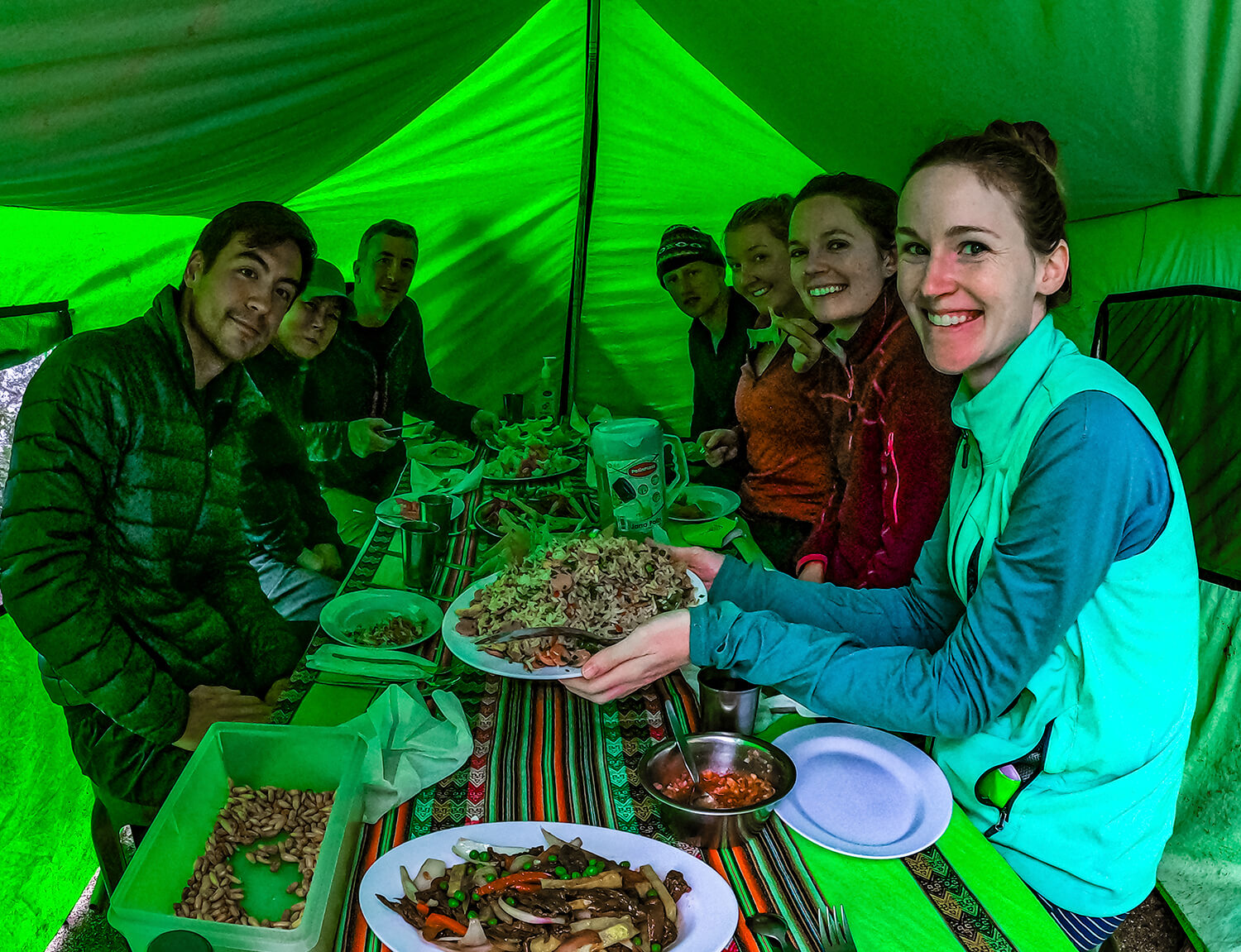


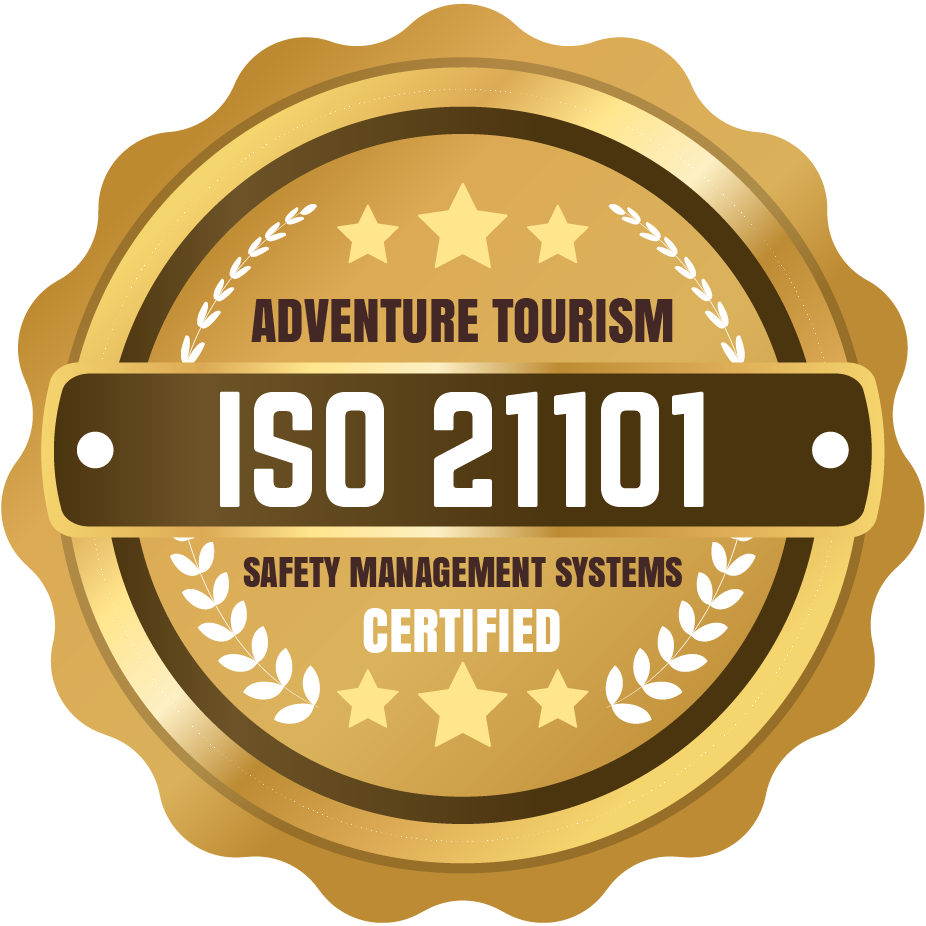
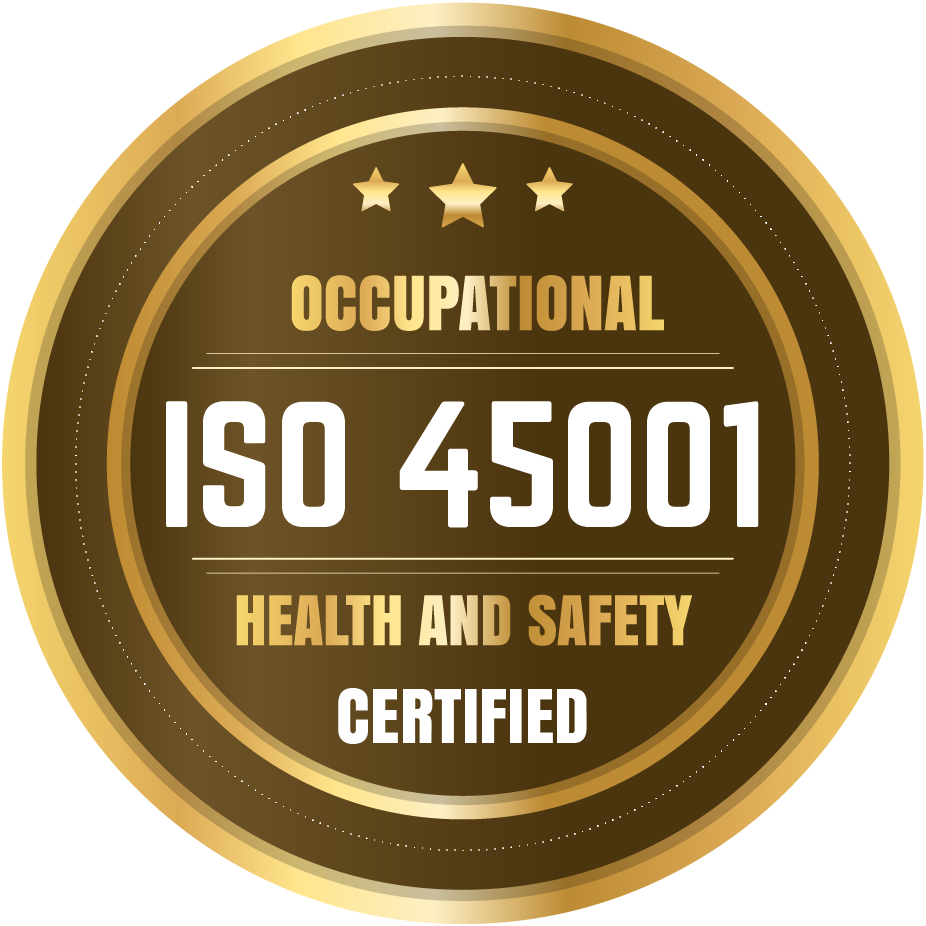
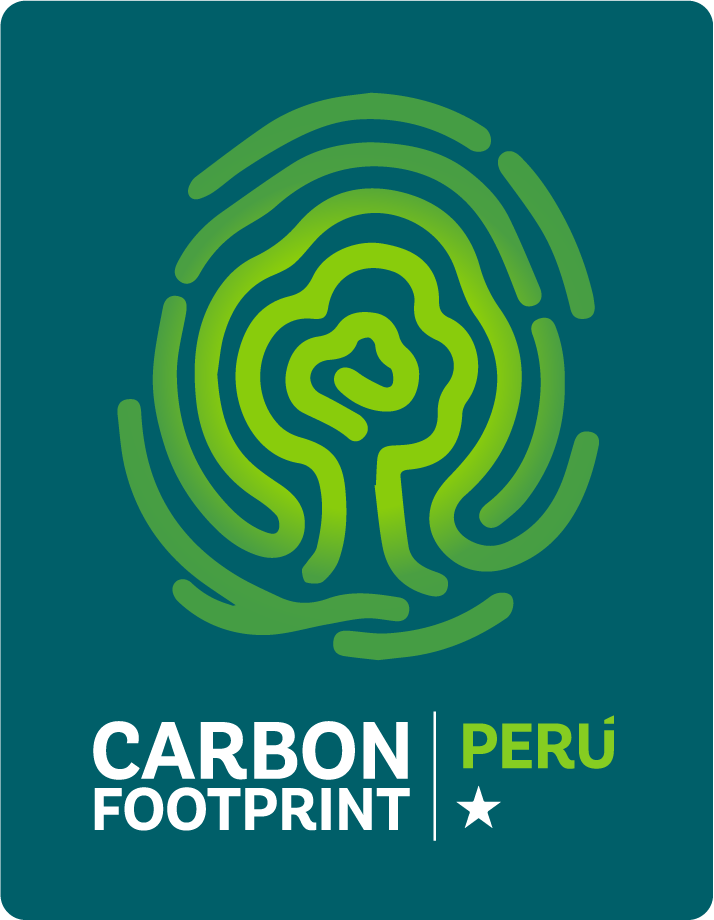
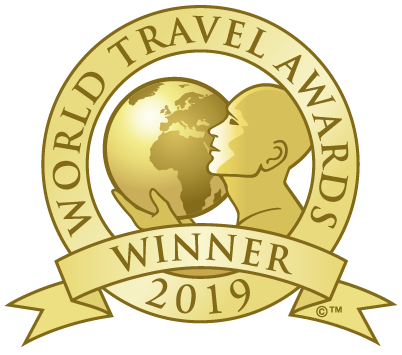
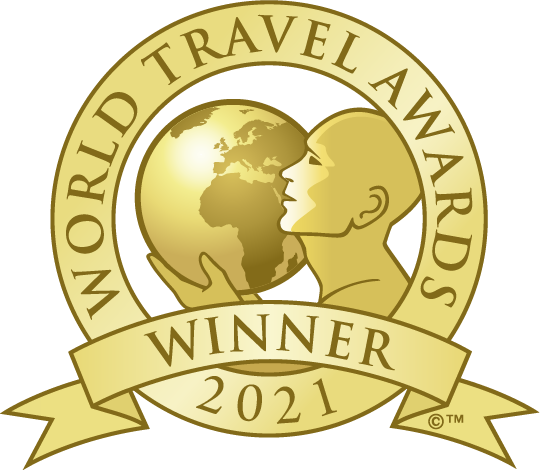












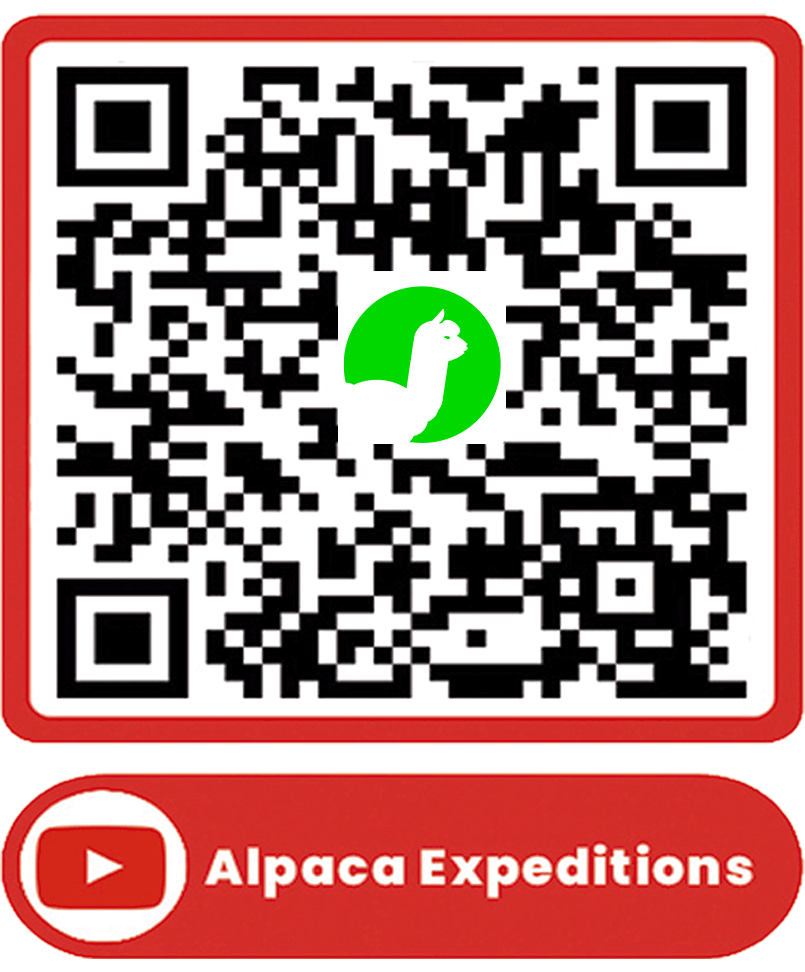

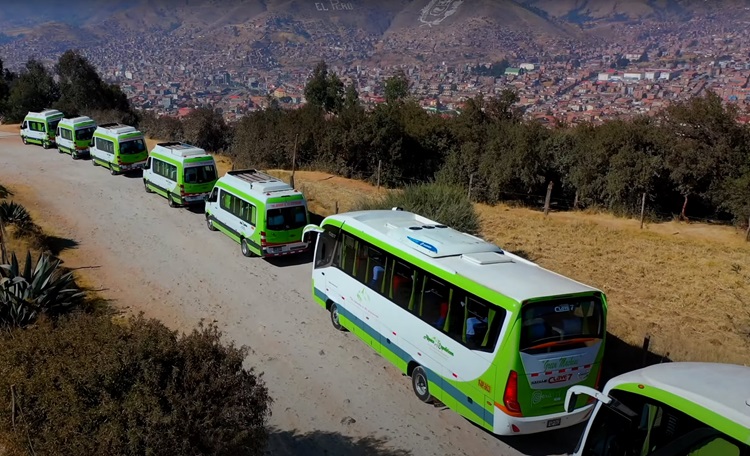
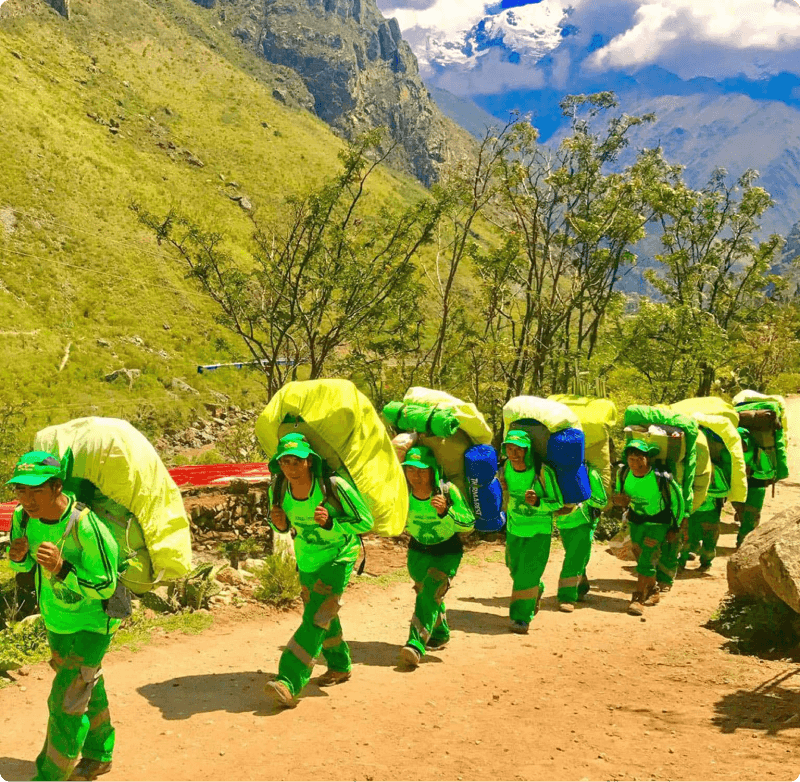 Porters will carry up to 7 kg of your personal items, which must include your sleeping bag and air mat (if you bring or rent one). From us, these two items weigh a combined total of 3.5 kg.
Porters will carry up to 7 kg of your personal items, which must include your sleeping bag and air mat (if you bring or rent one). From us, these two items weigh a combined total of 3.5 kg.